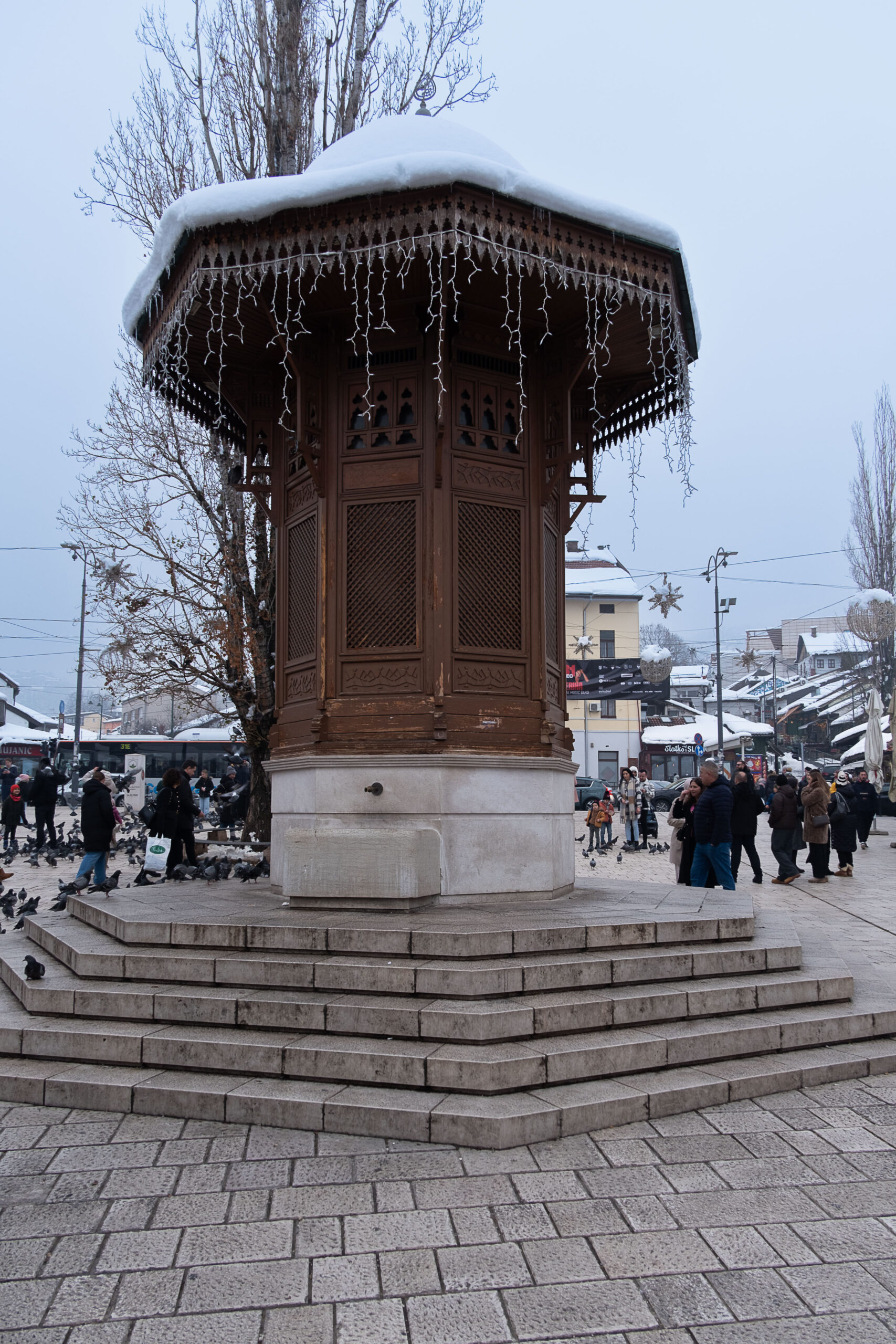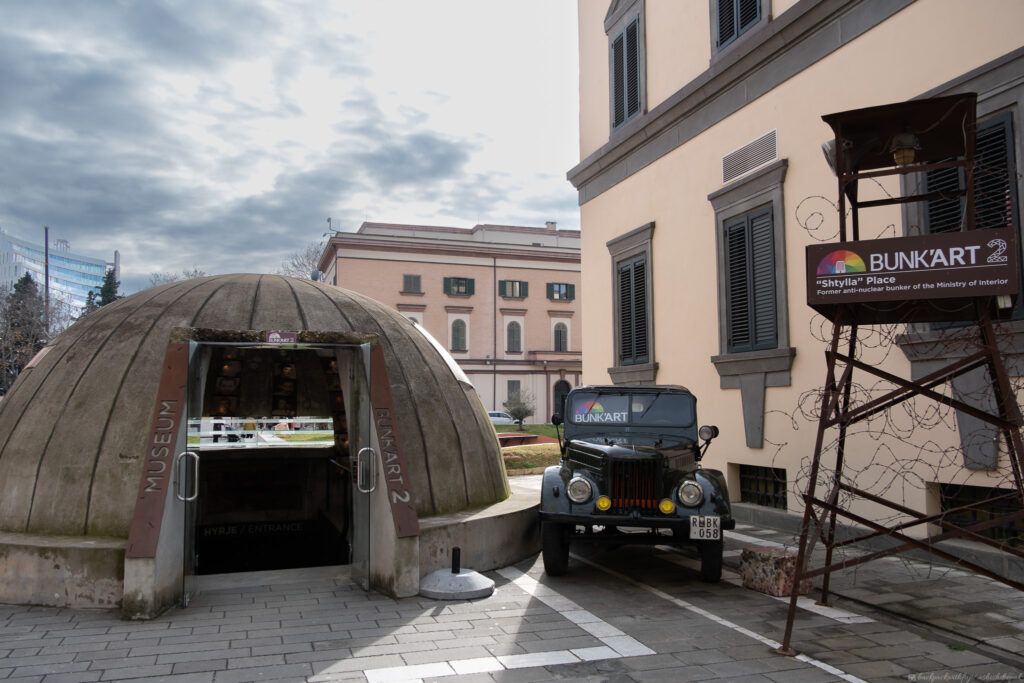Bus journey to Sarajevo
We took an early morning bus from Kotor to Sarajevo. Tickets can be booked using GetByBus Kotor to Sarajevo bus tickets costing around 30 – 35 euros per person. Before boarding the bus, you must pay 1 euro station tax at Kotor. Do expect the driver to charge 2 euros for the luggage that will be stored. This is not included in the ticket.
The bus ride is scenic as you would be driving through the mountains. Sooner or later, you will leave behind the Mediterranean climate in Kotor to snowy landscapes. Border checking was fast as we had already done our city registration in Kotor. In the Bosnian border control be ready for some questions about your accommodation in Sarajevo and the reason for the visit. Do carry enough water and snacks as the journey is around 7 hours.
Carry some euros in cash because you will need them to exchange for Bosnian Marks at stops to use the toilets.The journey passes through some notable cities like Mostar, Jablanica, and Konjic before reaching our final destination. Journey offers some great scenery and also the area that was part of the tragic 2024 Bosnian flash floods.
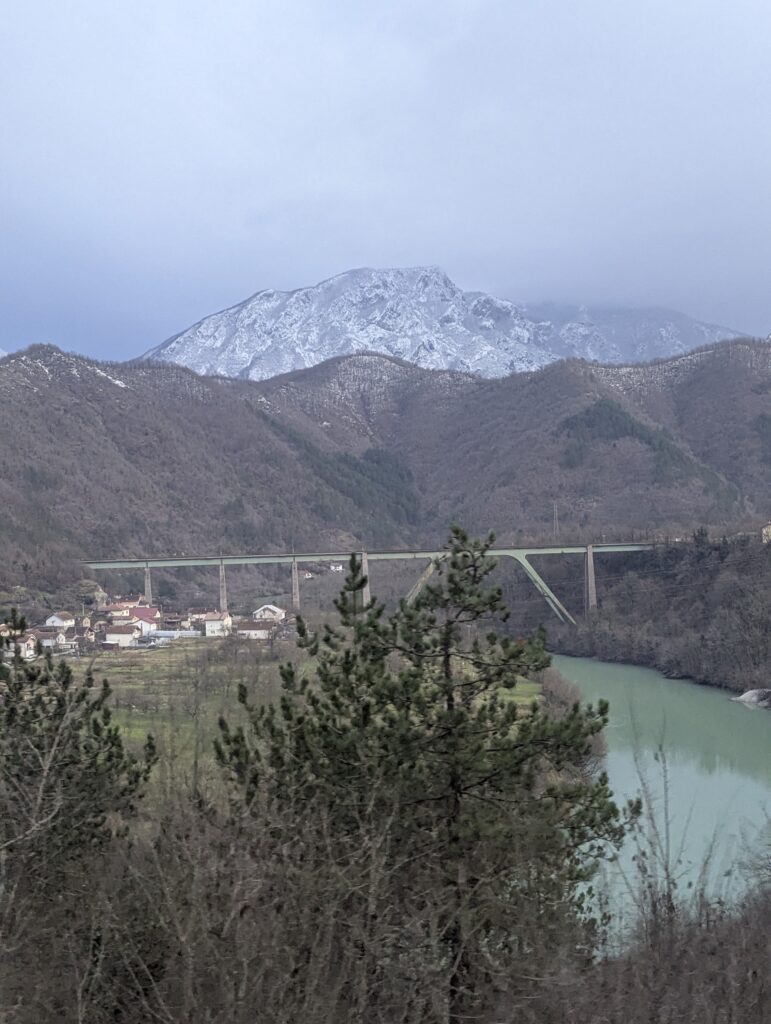

Sarajevo Bus Station and Taxis
Due to heavy snowfall, the roads were all slippery and mushy. There is a taxi stand just outside the bus station operated by Sarajevo Taxi. There are two apps recommended by people online- Mojtaxi and Zuti Taxi. Unfortunately, the Zuti taxi app was not available and the MojTaxi app is a call-back service if a taxi request is successful.
The most mentioned taxi is Crveni Taksi (Red Taxi). I had no other option than to call the taxi services. Luckily, my call went through and the lady who picks the call did speak English. She will tell you the approximate time the taxi would take and also the Taxi identification number instead of their number plate which is easier to remember.
Be careful of pickpockets. We were luckily alerted by a few locals about a woman who was trying to pickpocket my wife's handbag.The taxi ride normally takes 11-25 minutes based on the traffic. Our room for the next two days was Apartman Bistrik 1. You can book this cosy but elegant apartment via Agoda Apartman Bistrik 1- Agoda.com or Booking.com Apartman Bistrik 1- Booking.com. Our hosts Senad & Aiša were really sweet and helpful. Senad showed us around the house and gave us some initial details around the place regarding shopping, and getting to the old town. The room has all the amenities like a washing machine, kitchenware and lots of blankets.
The room is located up a steep slope. The old town is reachable by foot but while coming back it is best to take a taxi from Latin Bridge. It would cost around 2 euros thus avoiding the slippery roads in winter. There is an Amko Komerc supermarket to get snacks and food.
Exploring Sarajevo
The next morning, we set out to explore Sarajevo and its famous Old Town. Our first stop was the ever-famous Latin Bridge, the site near the assassination of Archduke Franz Ferdinand of Austria which led to the outbreak of World War I. The bridge is crowded by tourists and locals alike.
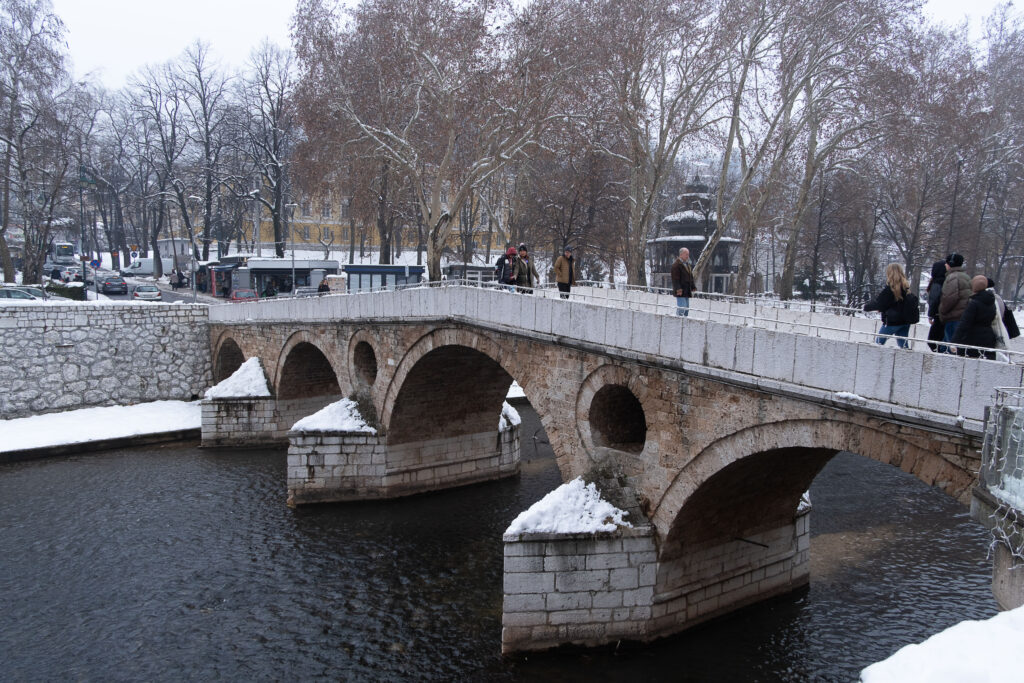
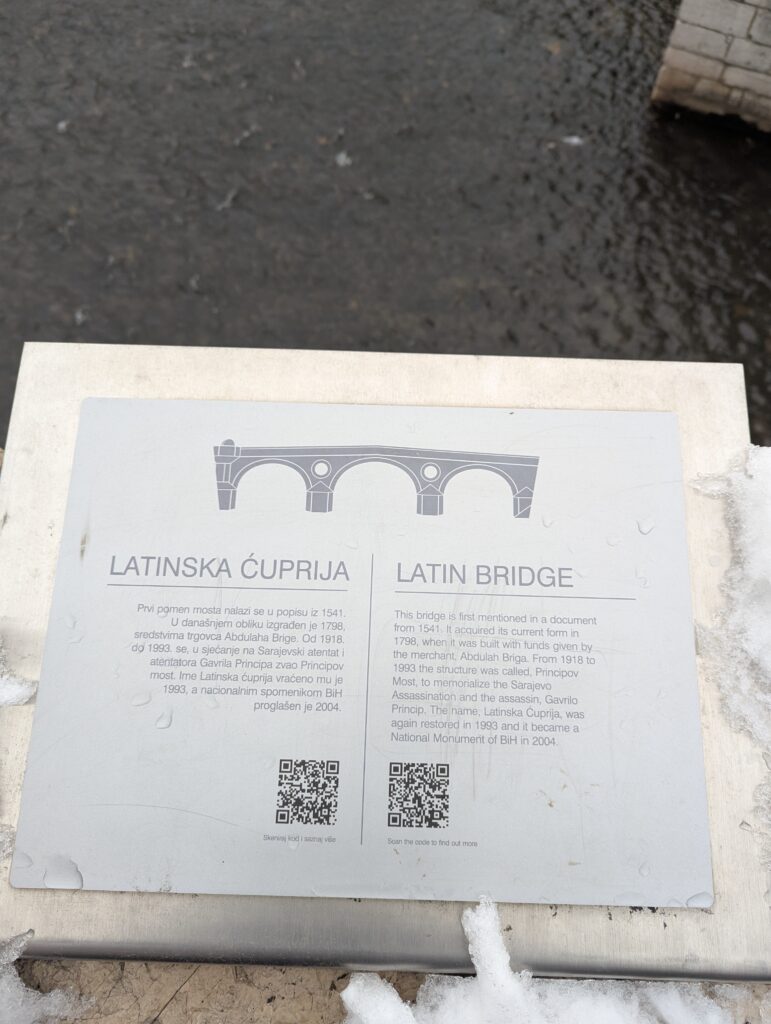
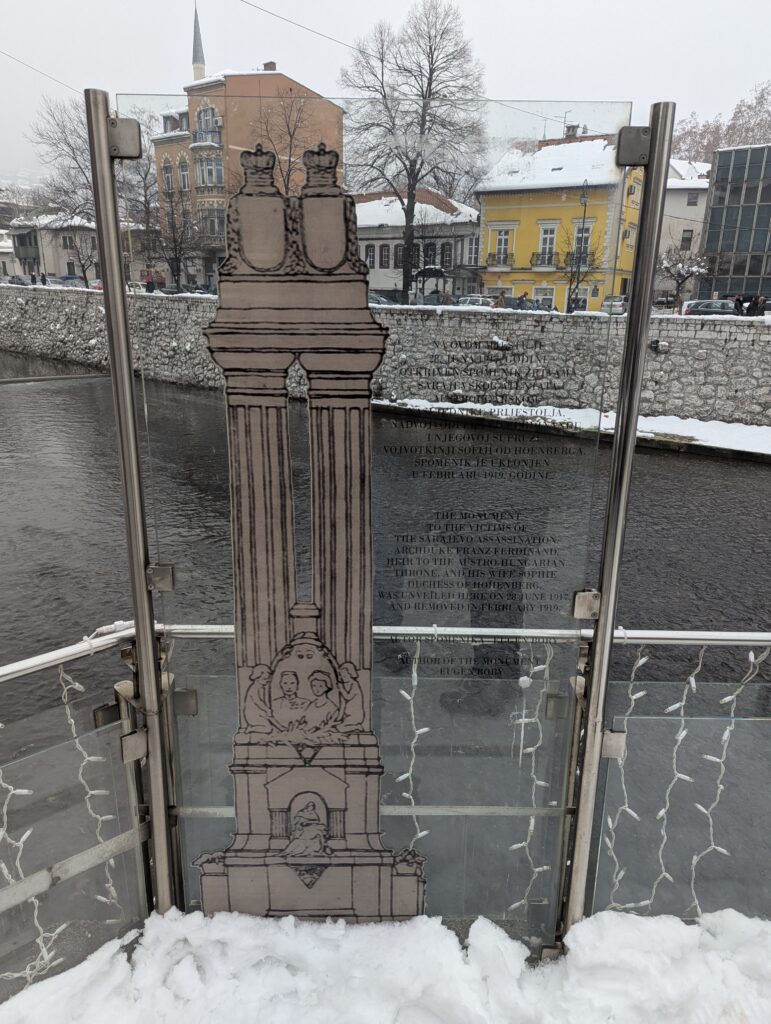
After crossing the bridge, on the right side of the road lies the famous spot from where Gavrilo Princip shot Archduke Franz Ferdinand and his wife. The location is marked with a footprint and a plaque.
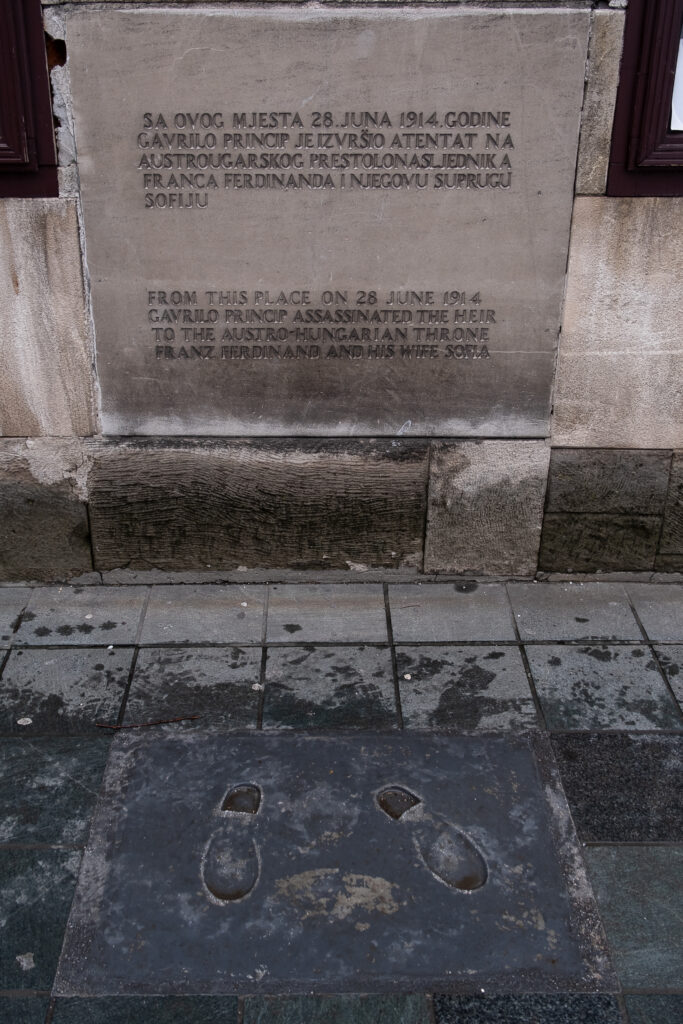
The building next to it is a museum which hosts historical articles and items from 1878 – 1918. The museum is named Sarajevo Museum 1878 – 1918. Some of the items displayed are the old Bosnian flag, the Proclamation of the Annexation, the Austria-Hungary map and also the assassination plan of Archduke Ferdinand and the pistols used.
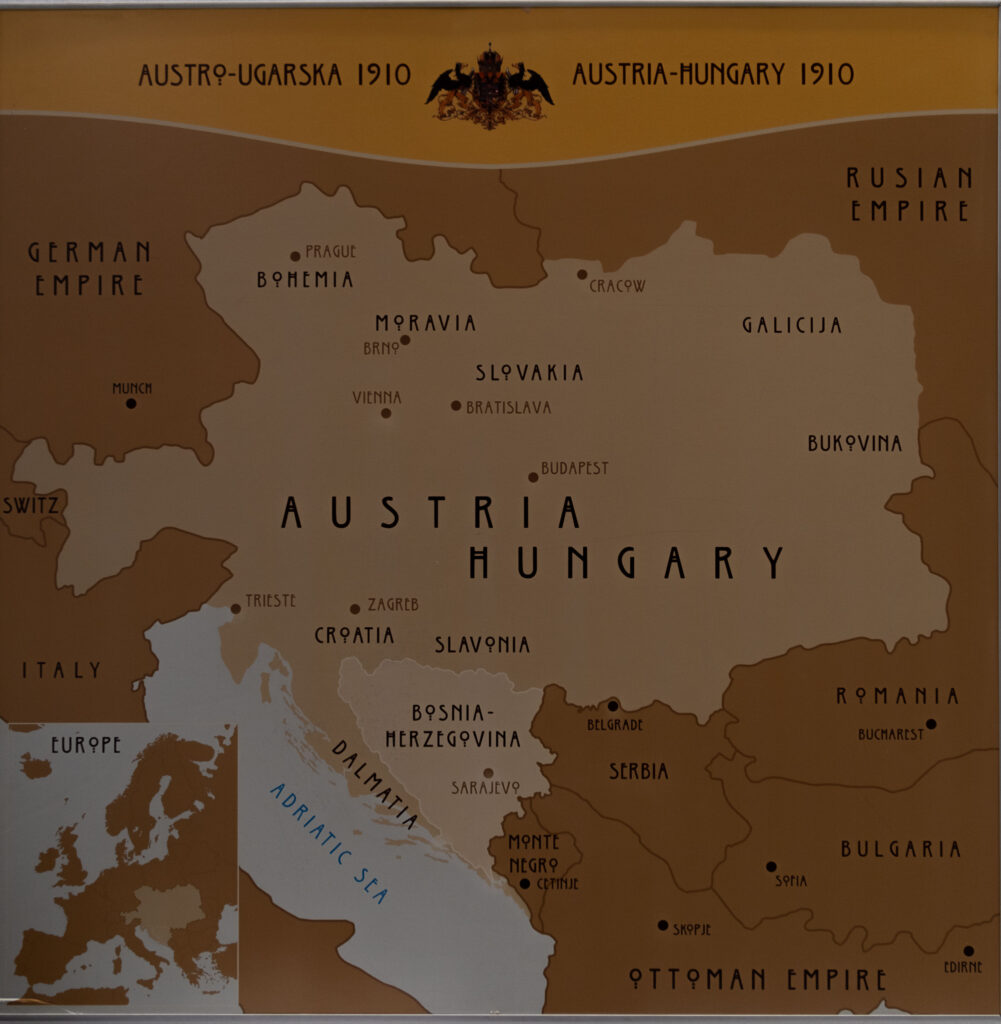
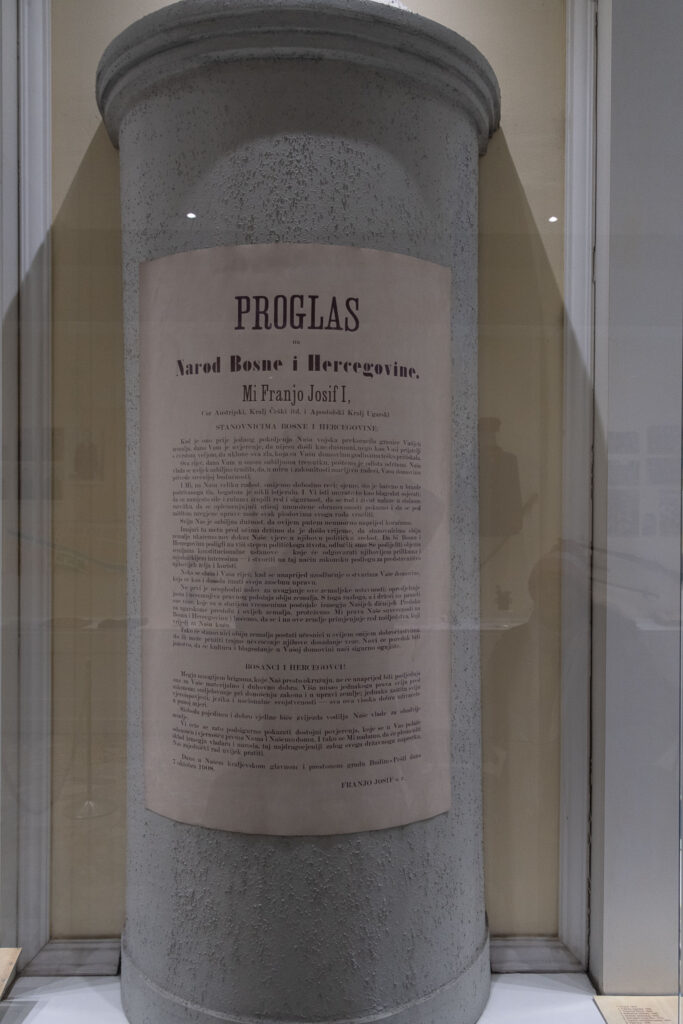
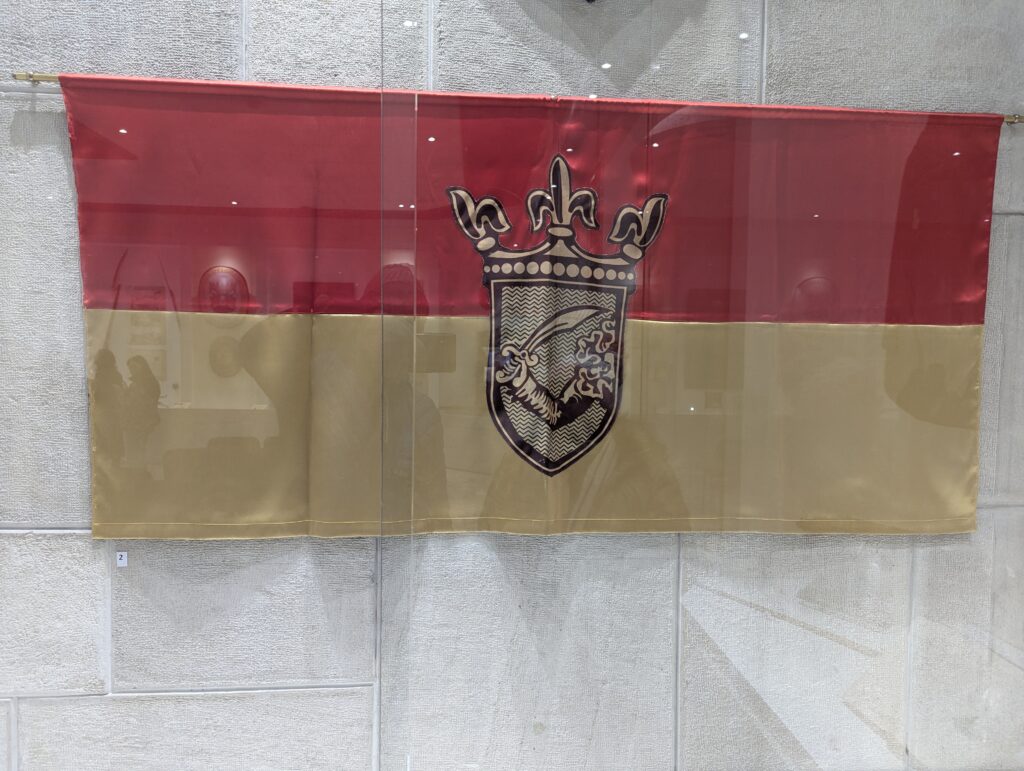
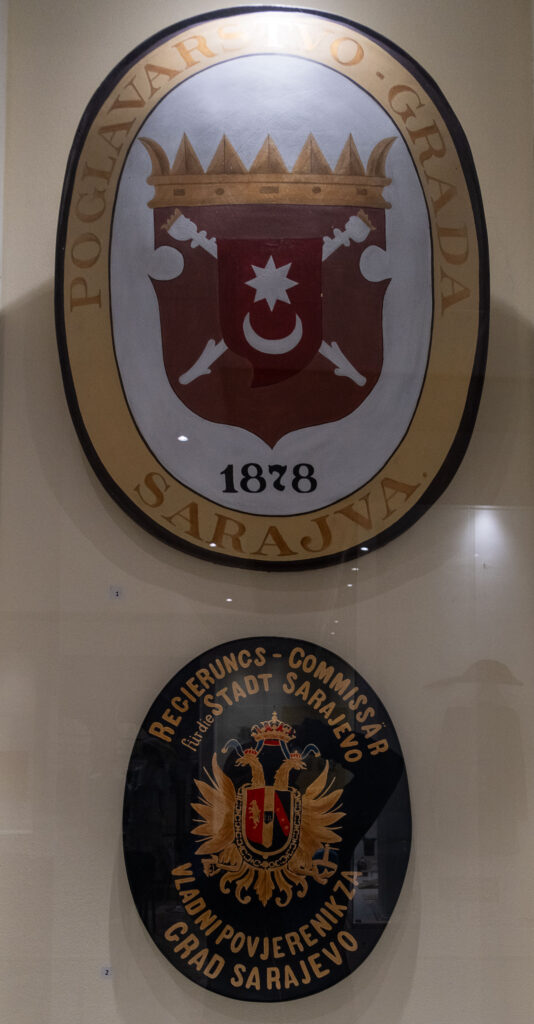
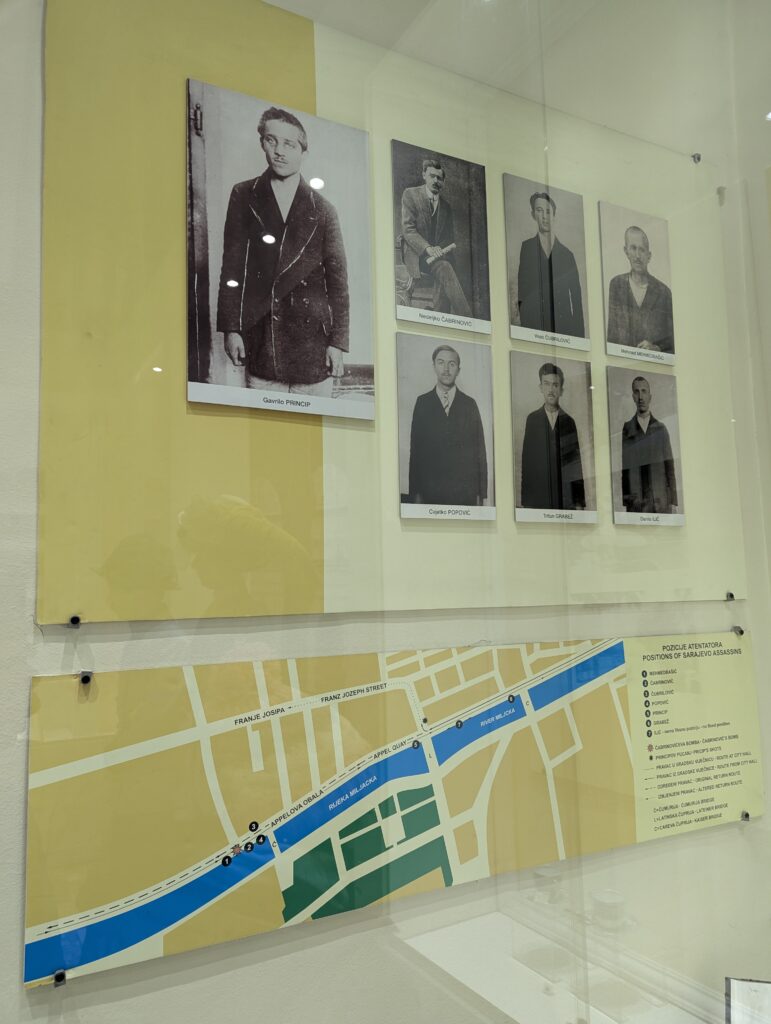
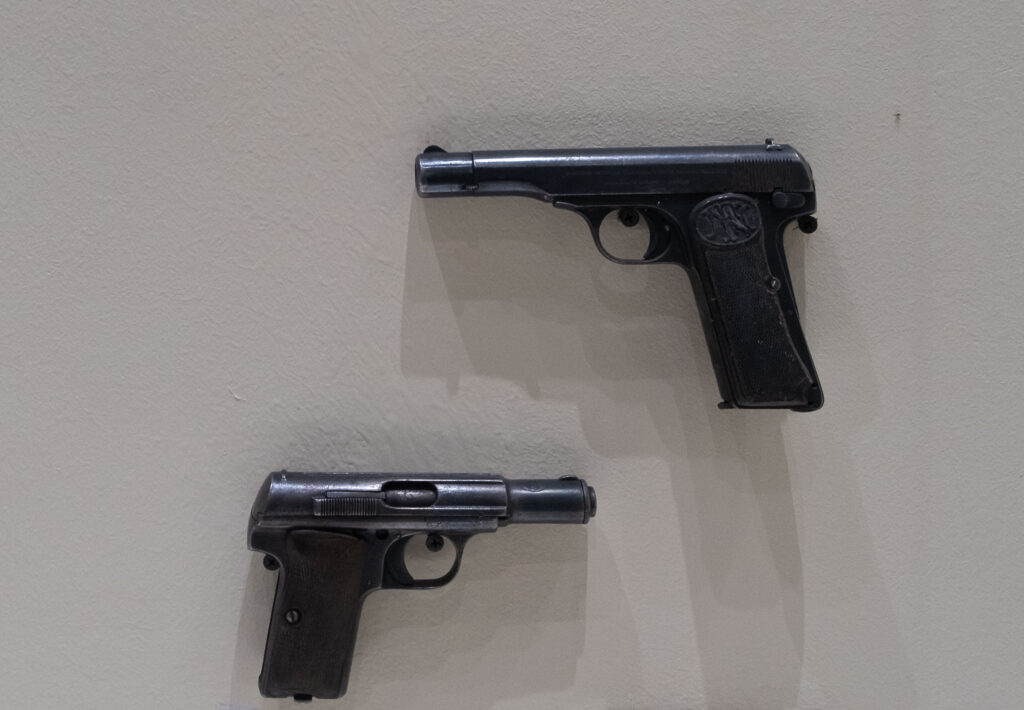
Stari Grad- bustling old town market
After the museum visit, we entered the bustling Old Town of Sarajevo. It was filled with locals and tourists. The street is lined with souvenir shops, restaurants, and cultural landmarks. Our first stop was the Gazi Husrev-beg Mosque, the largest historical mosque in Bosnia and Herzegovina and one of the most representative Ottoman structures in the Balkans.
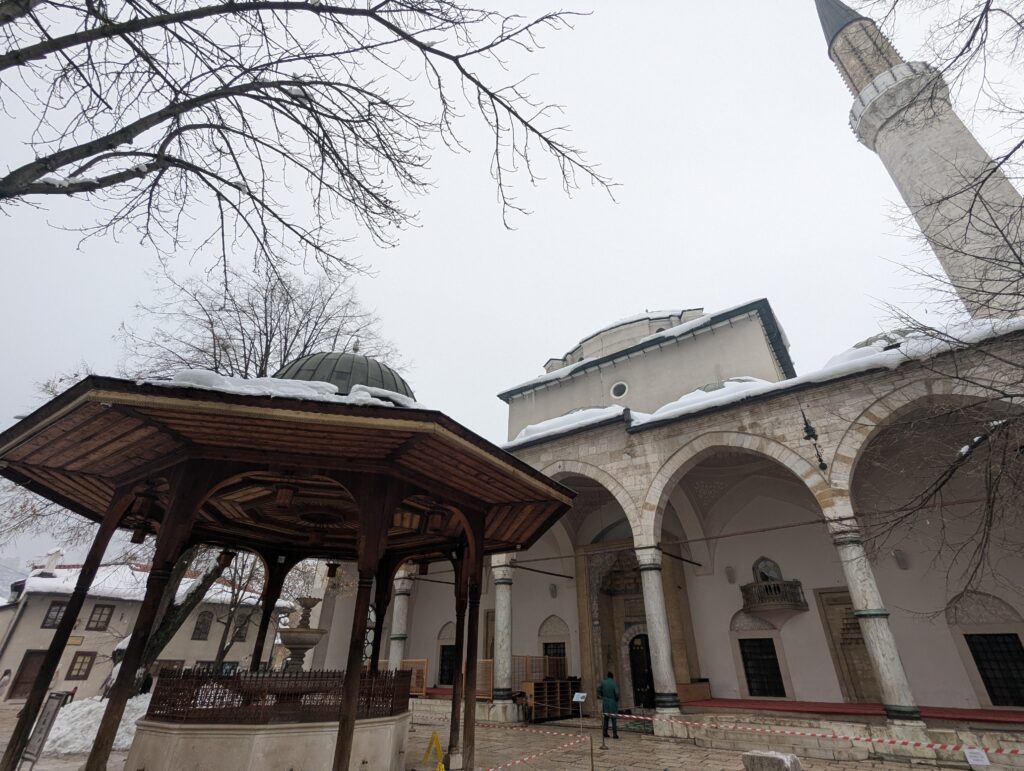
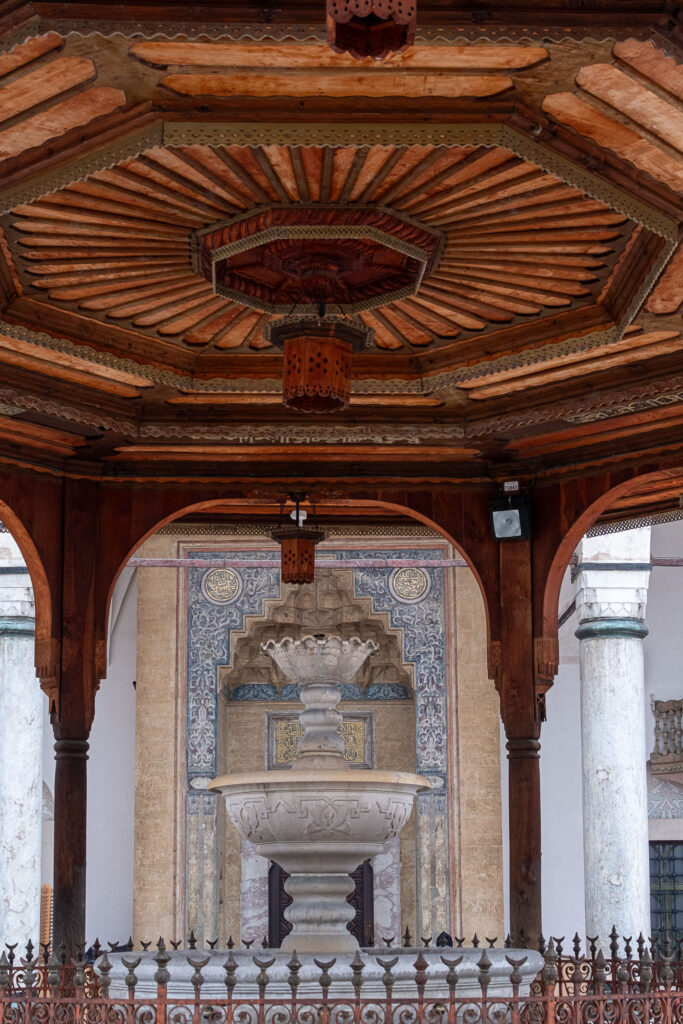
Outside the mosque, a few metres down the road is another cultural landmark – the Sarajevo Meeting Of Cultures. This is the spot that shaped the cultural differences in Sarajevo. The point is also known as “East meets West”– with the East considered Ottoman and Islamic and the West seen as Austro-Hungarian and Christian. As you stand on the mark, on the Eastern side we have the mosque, sweet shops and the famous Ottoman market Baščaršija and on the Western side, we have buildings built in Western Architecture.
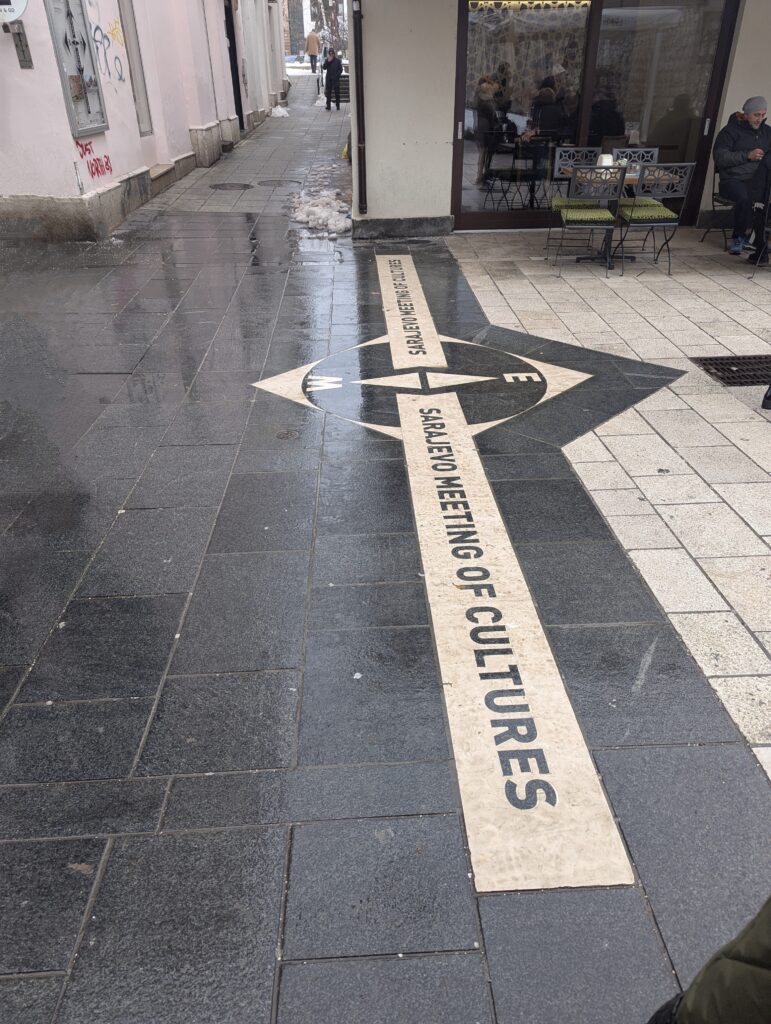
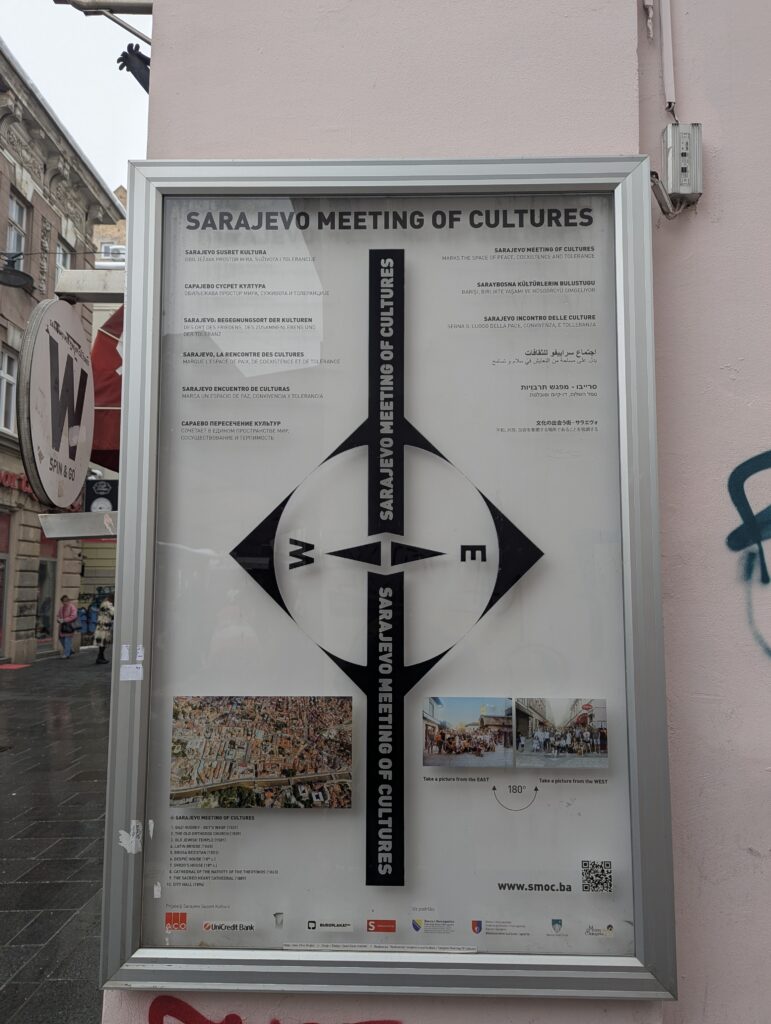
Adjacent to the meeting of cultures is Gazi Husrev-beg’s Bezistan– an indoor marketplace for souvenirs, shawls, spices and pieces of jewellery. It reminded me of the souks in Qatar.
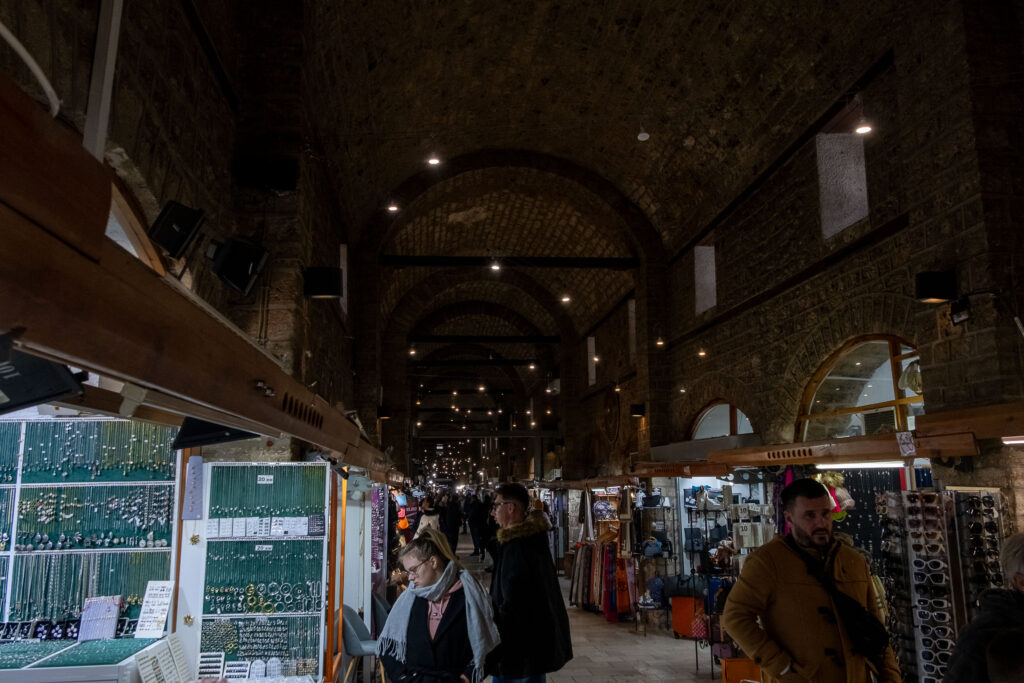
As mentioned in the earlier paragraph on East meets West, the Eastern part is loaded with a lot of restaurants, cafes and clothing stores. You can try some authentic Bosnian foods in these restaurants. We stopped for lunch at Kolobara Han– a traditional Bosnian restaurant. We gave it a try with Hajj ćevap– a mushroom and veal sauce dish served on a flatbread that’s stuck onto the bowl acting like a packet.
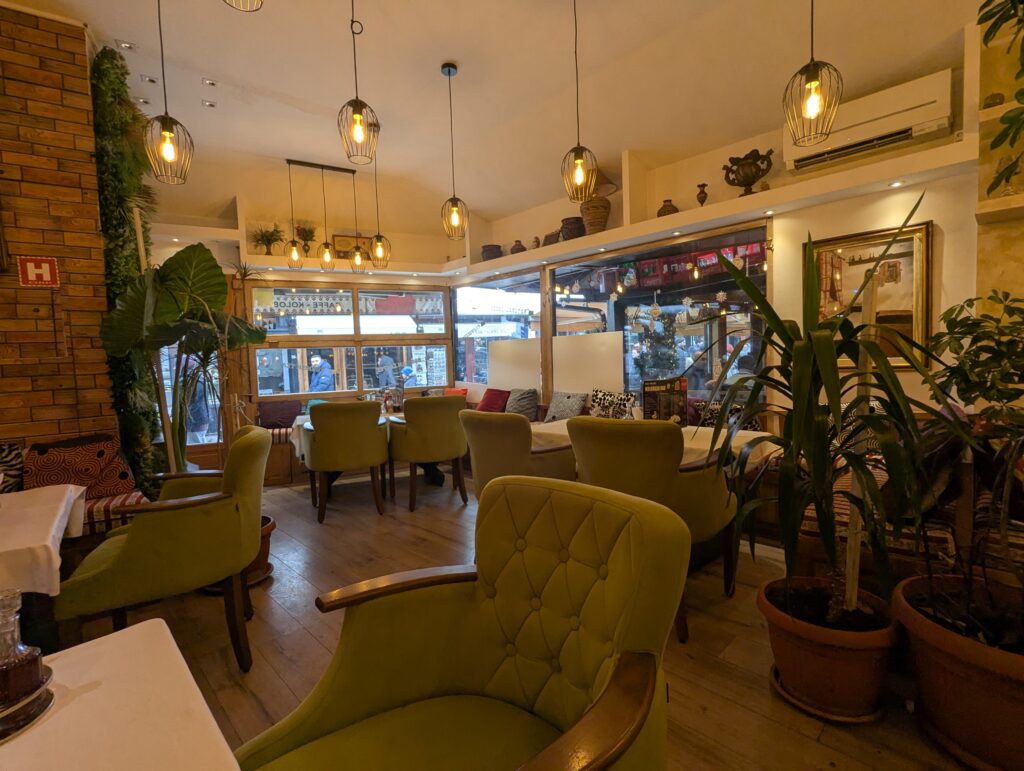
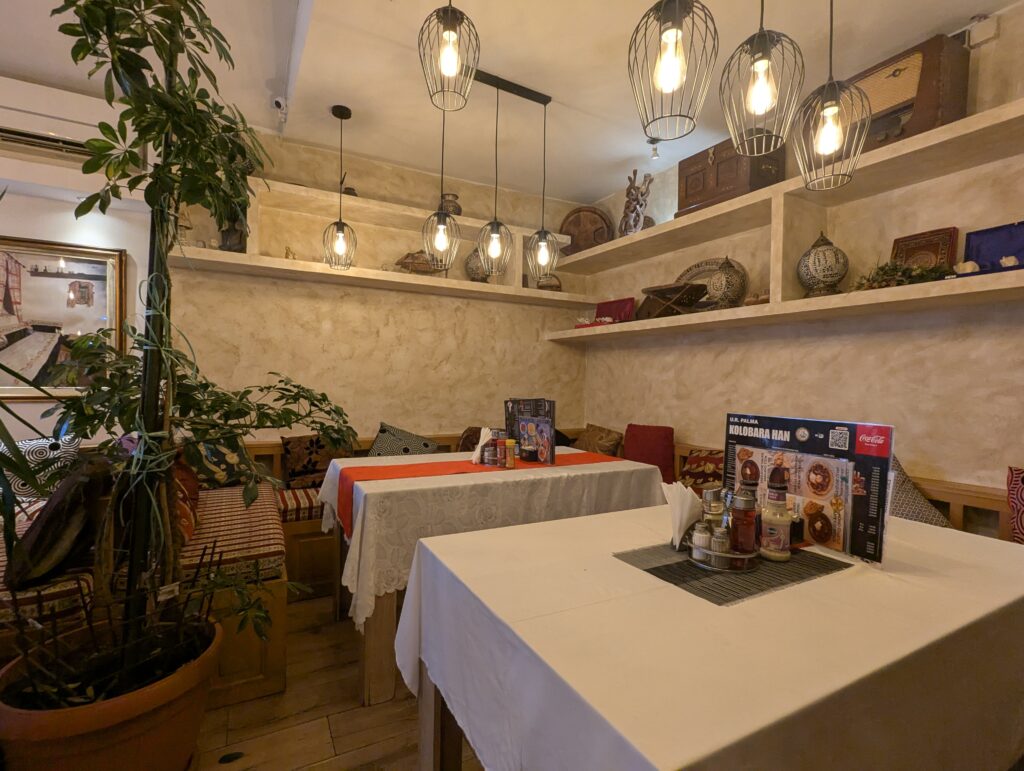
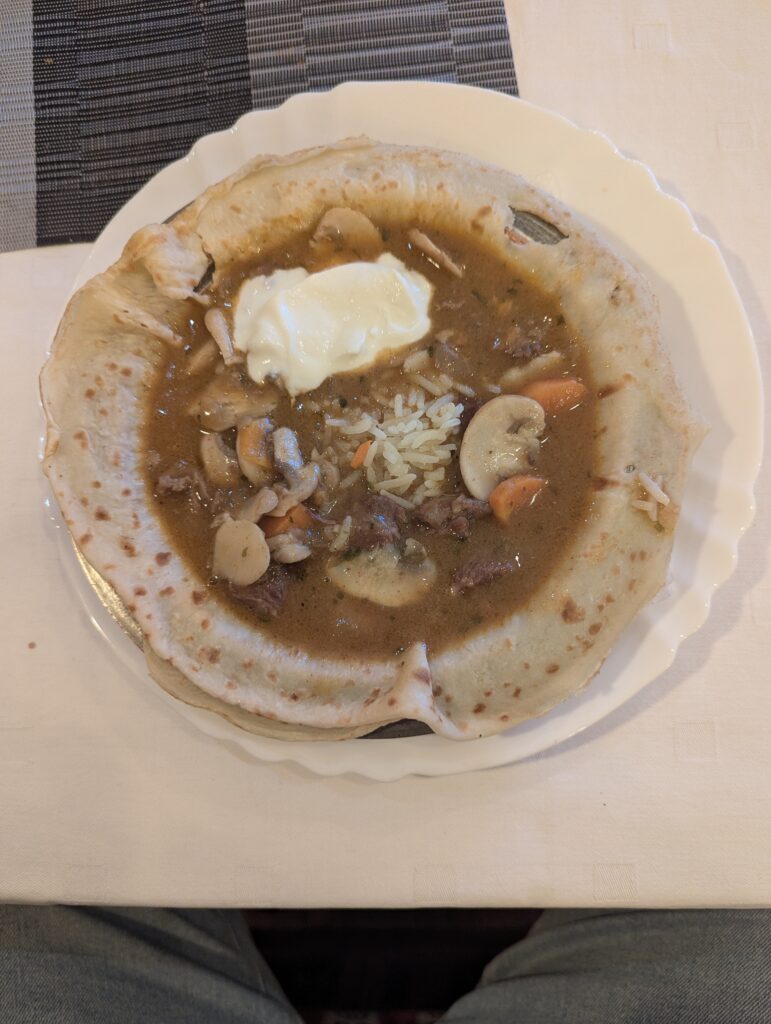
Baščaršija
After lunch, we set out to explore the Old Ottoman markets dating back to the 1400s – Baščaršija. The cobbled streets are lined with souvenirs and colourful decoration items which take you to Turkish markets. We took a stroll through the streets before grabbing some souvenirs. The most noticeable items are Turkish teapots and Alaadin’s magic lamp.
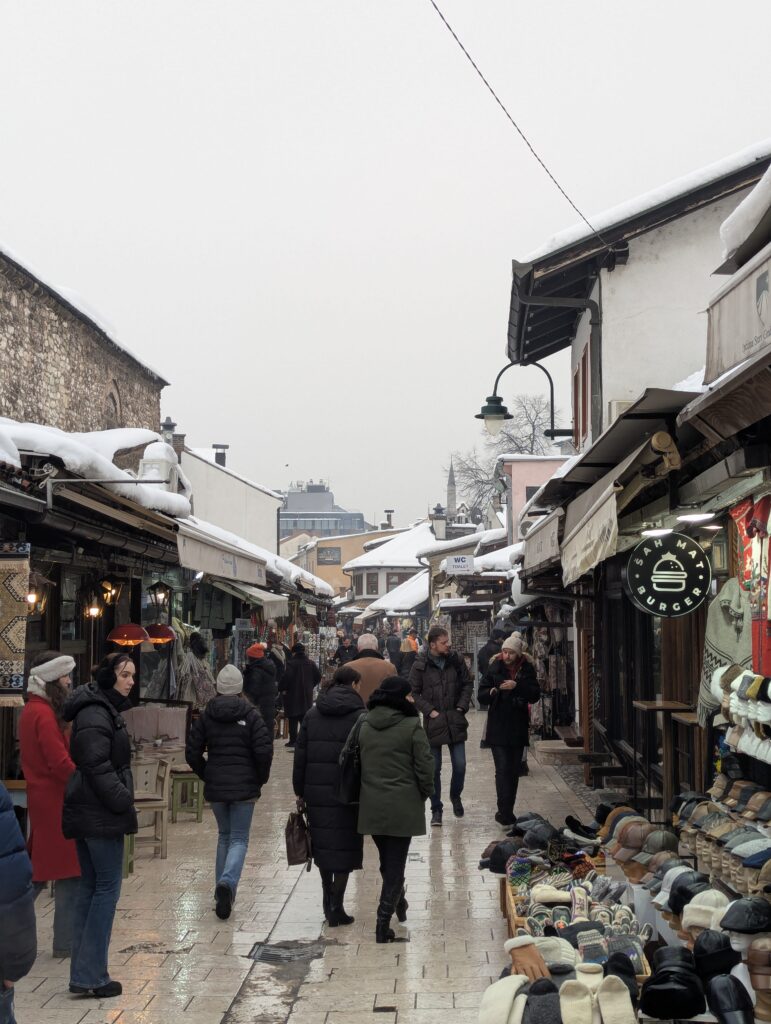
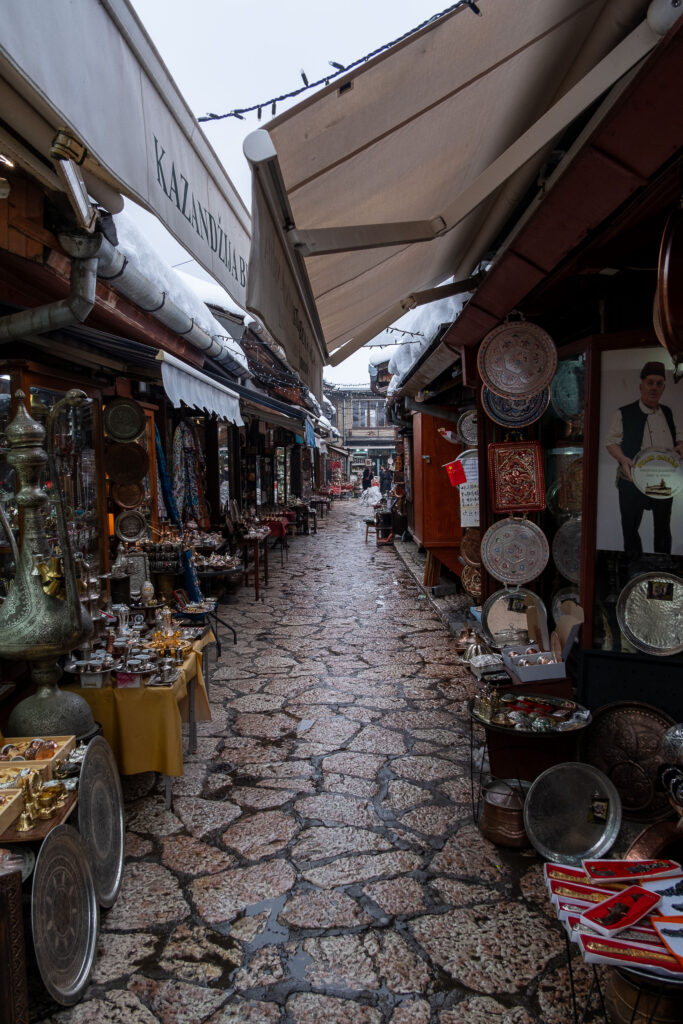
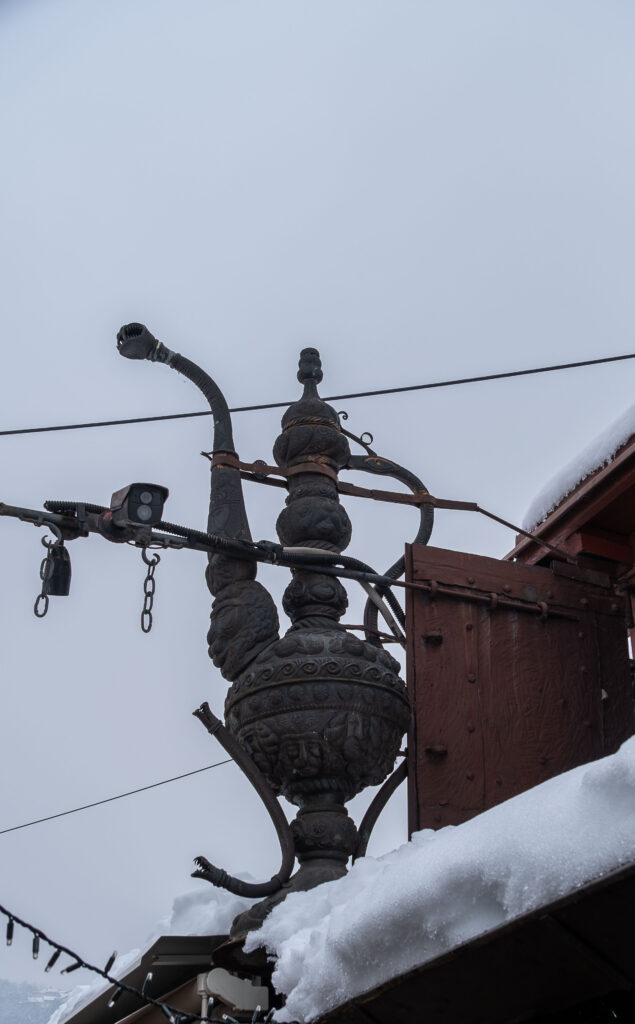
In the centre of the Baščaršija Square is Sebilj, an Ottoman-style wooden fountain from the 1700s. According to local legend, visitors who drink water from the fountain will return to Sarajevo someday. Behind the fountain is the famous Pigeon Square, where people can feed Pigeons.
Historically there is a popcorn cart where a man sells unpopped corn kernels for 2 BAM (1 EUR). A better option is to buy grains from nearby shops which is cheaper and good for the pigeons.

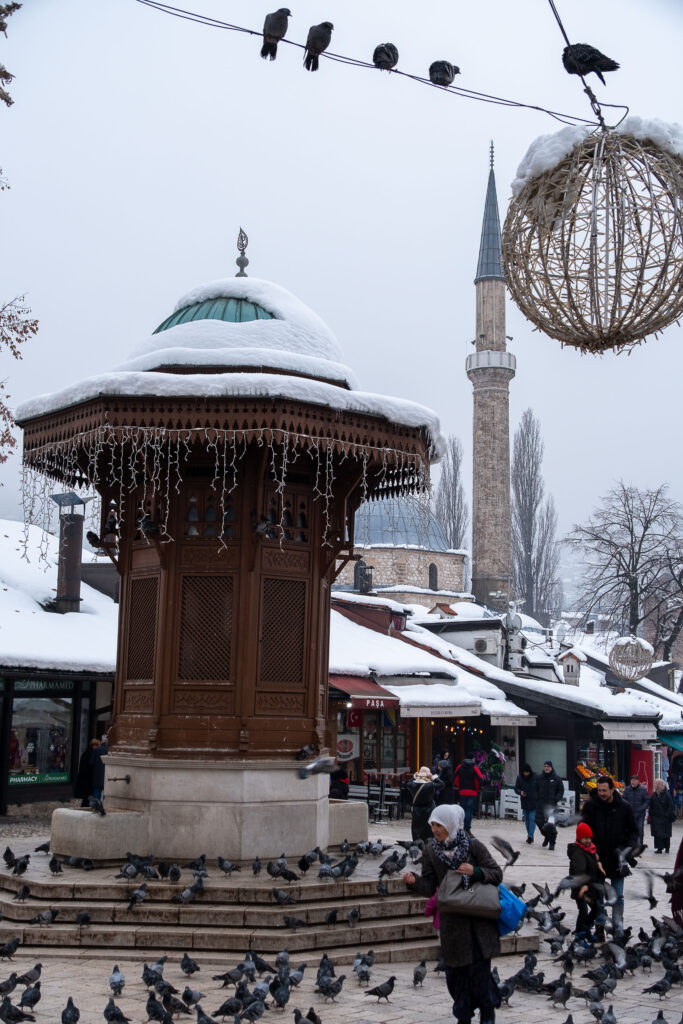
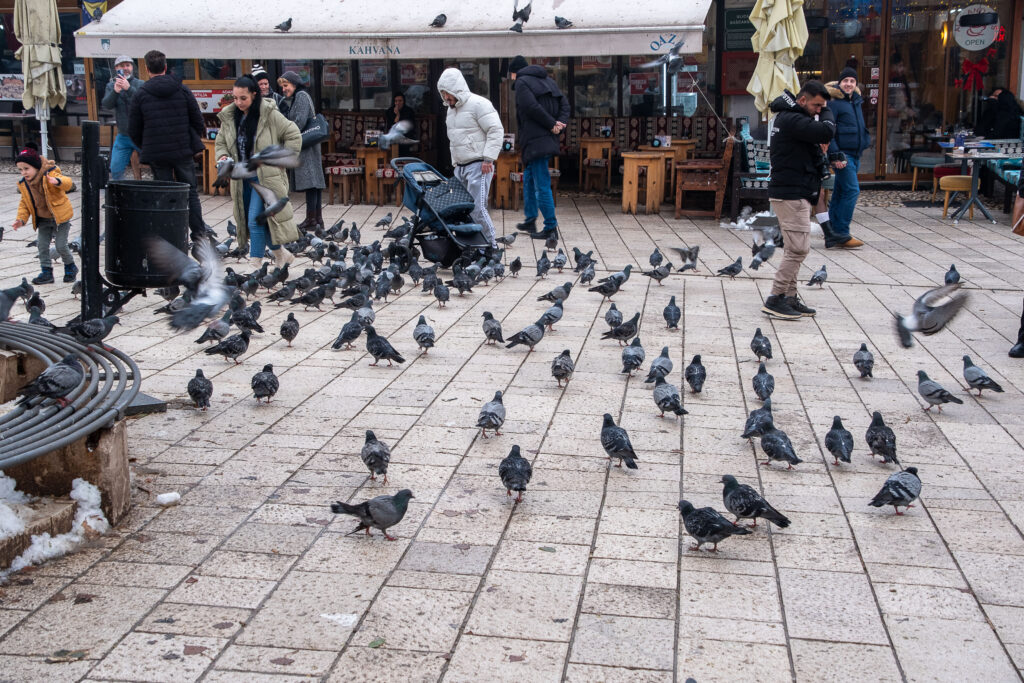
Our next day was a day trip with MeetBosnia Tours to Mostar with other attractions like Konjic Old Bridge, Počitelj Village, Počitelj Village and Blagaj Tekke Monastery.
Day 2- A full-day trip with MeetBosnia Tours.
The tour started with Zrno picking us up from the apartment. We then picked up two other groups and our guide of the day Armina from their office. Armina was very insightful and shared knowledge about Sarajevo from its past to present. She explained how Turkey has been a very good friend to Sarajevo for many years. We were informed Sarajevo is also called the Jerusalem of Europe because of strong religious opinions among different communities.
Konjic
En route to Konjic, one can see the results of the war. Holes of shell shrapnel mark the buildings. It is a short stop at Konjic Bridge being the main attraction. The foggy morning made our photos look aesthetic and dreamy. To get a better view of the bridge, climb the steps on the opposite side of the road. The Old Stone Bridge spans over the Neretva River and is a national monument.
Konjic is famously known for its wood carving art which is a century-old craft. The pieces, including furniture and small decorative items, stand out because of their unique and hand-carved designs. It is part of UNESCO’s intangible cultural heritage.
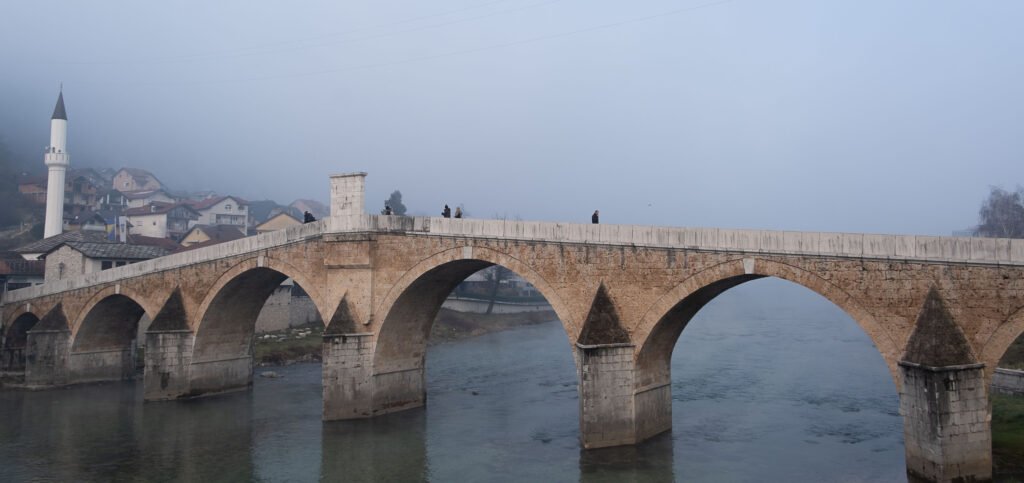
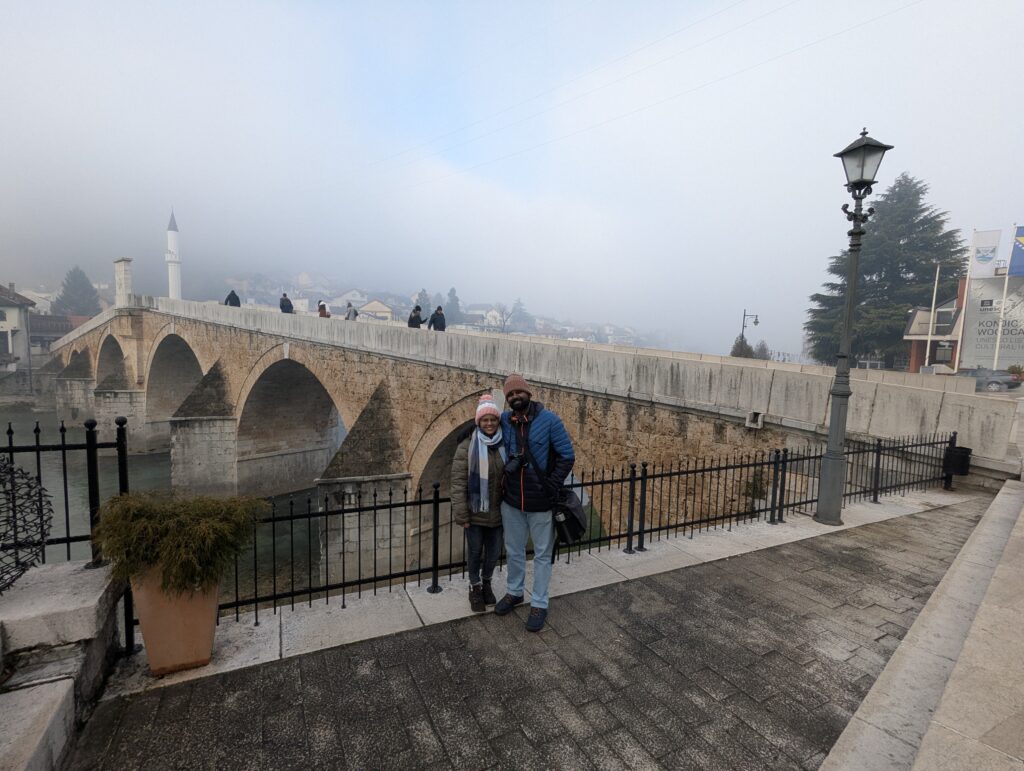
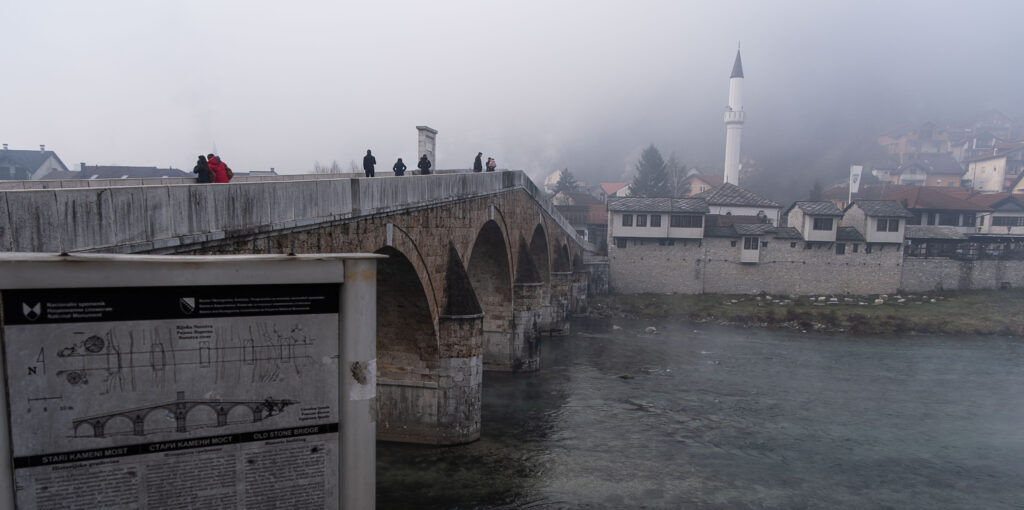
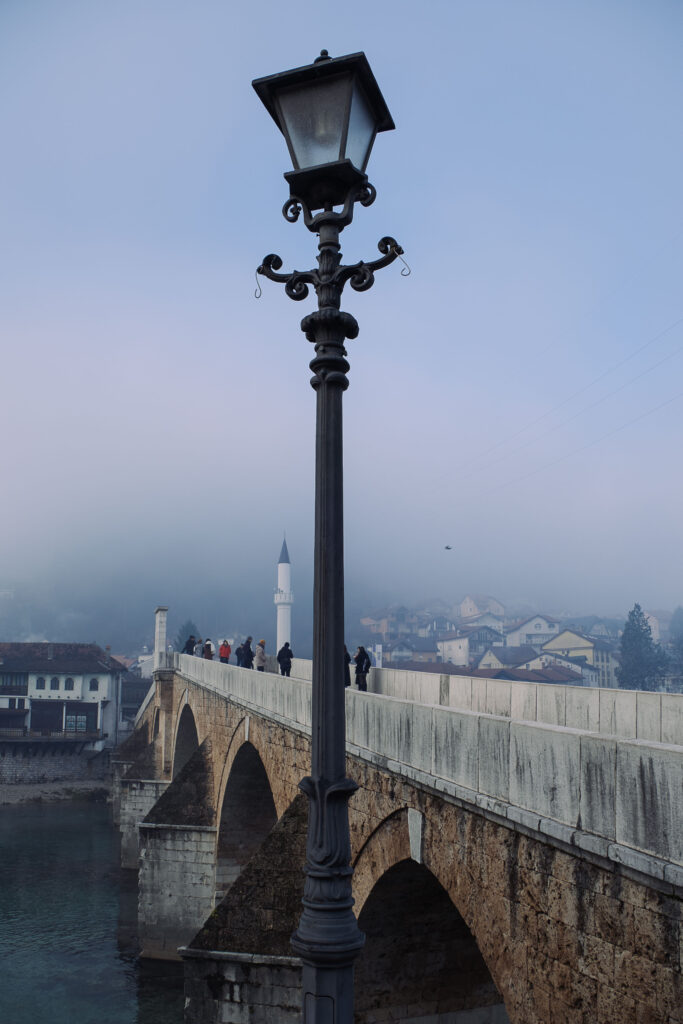
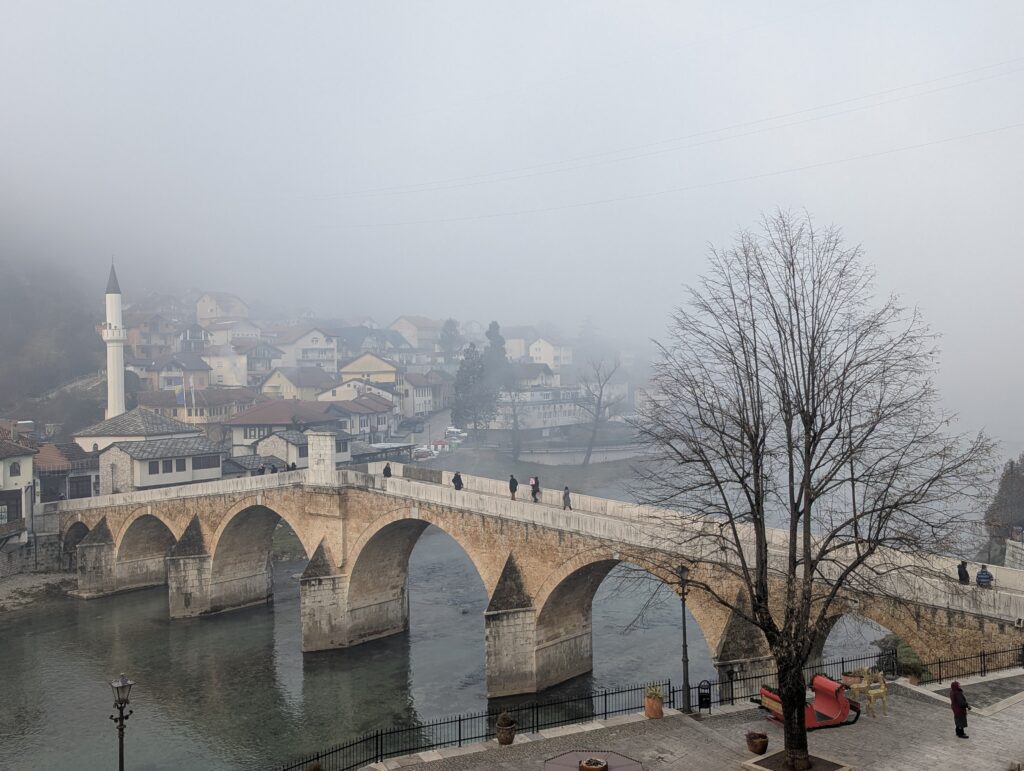
Jablanica
Before reaching Mostar, we made a short refreshment stop at Restoran Kovačević. The restaurant is famous for its technique of grilling lamb using hydropower to rotate the skewer. Visitors can enjoy the process and their lamb cuisines. The restaurant also offers dining with great views of the Neretva River.
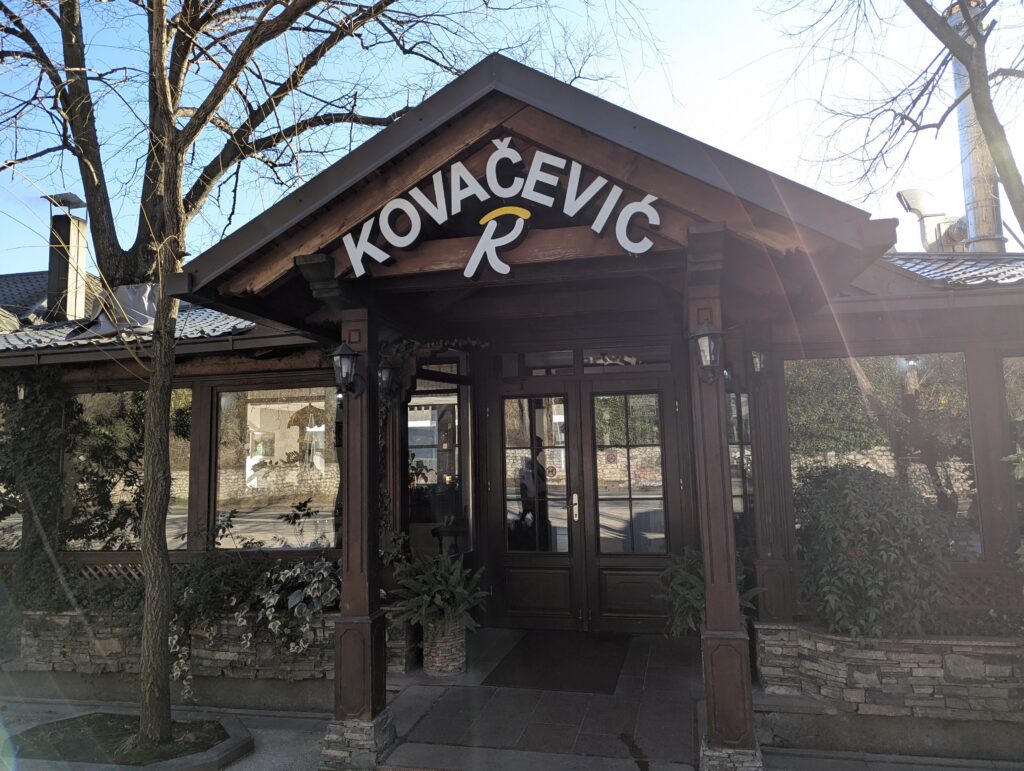
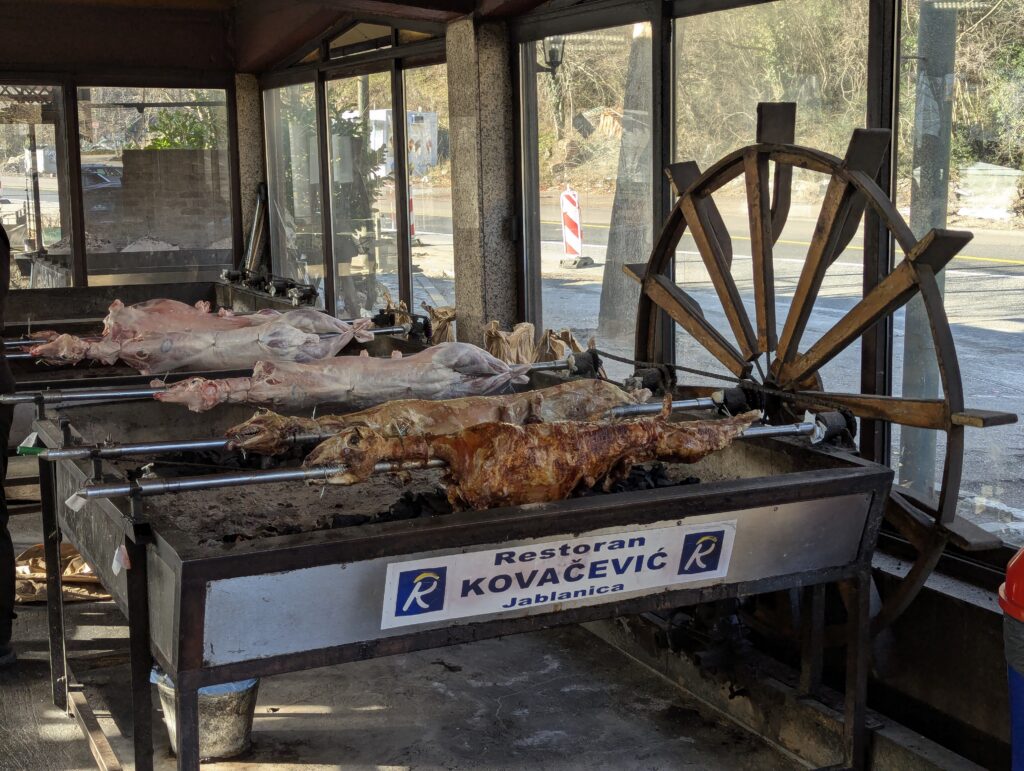
On the way, you will get to witness the most affected location in Bosnia which was destroyed by the flash floods and landslides in 2024.
Mostar- Capital of Herzegovina
As you approach the area of Herzegovina, the weather slowly shifts from winter to Mediterranean climate. Mostar was named after Mostari- the bridge keepers, who safeguarded the Old Bridge. It was commissioned by Suleiman the Magnificent, a famous Ottoman ruler. The old bridge, a UNESCO World Heritage Site was destroyed in the Bosnian War. The bridge was reconstructed and opened in 2004. One can still see the bridge blocks from the Ottoman era near the banks.
You walk through the Crooked Bridge before taking the steps to the banks below the Old Bridge. This is the viewpoint for the most-seen photos of the bridge on the internet.
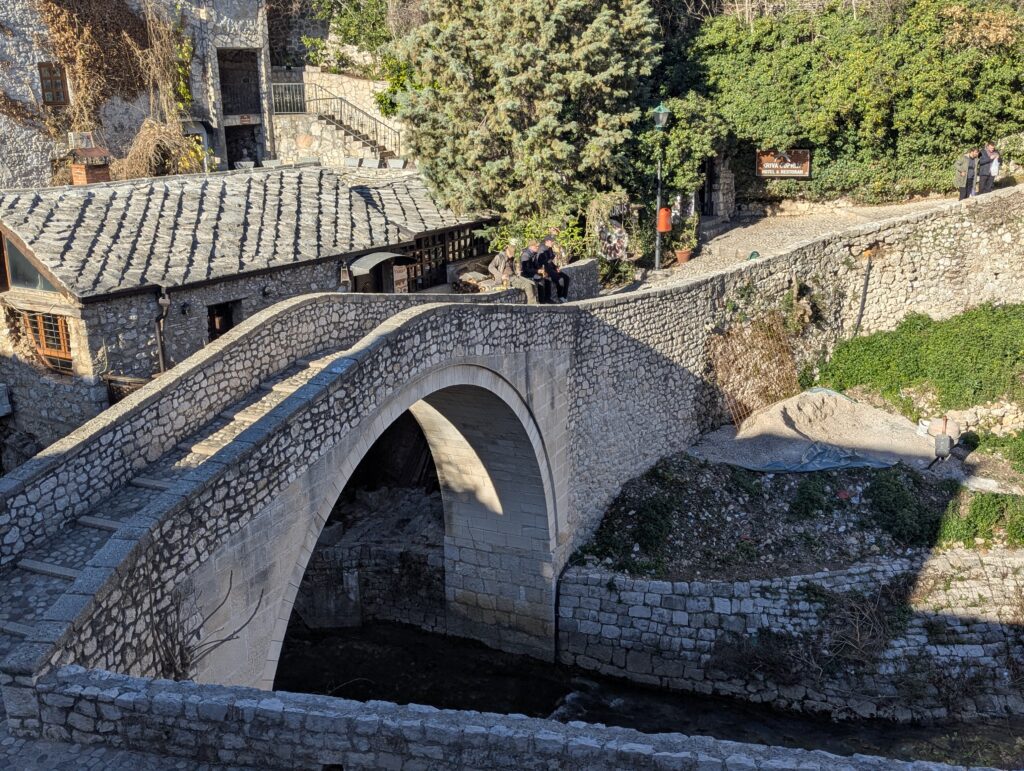
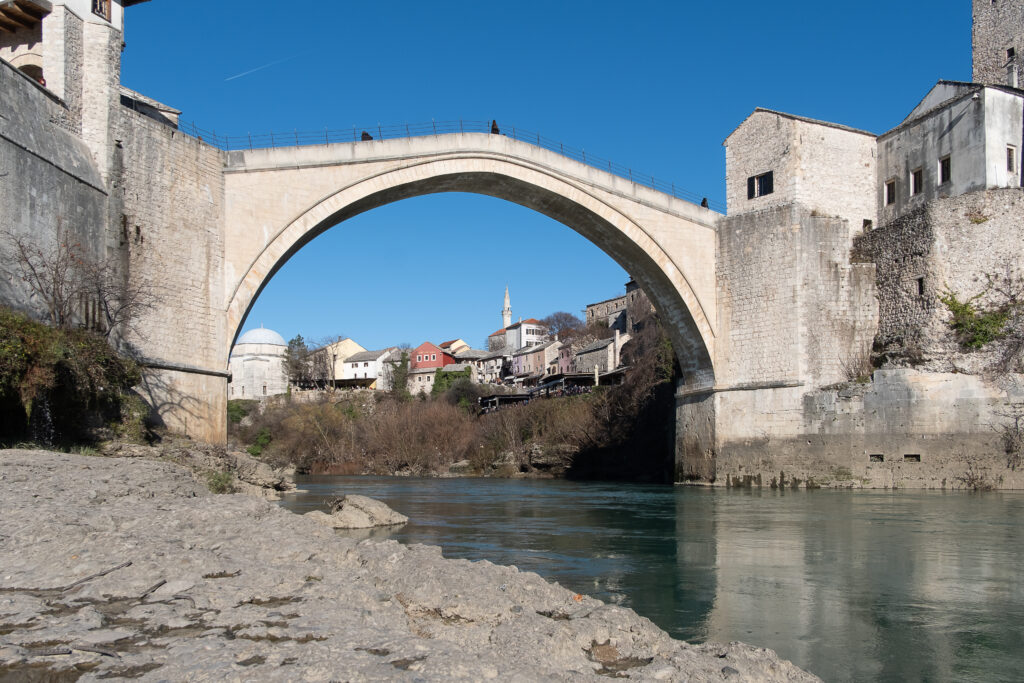
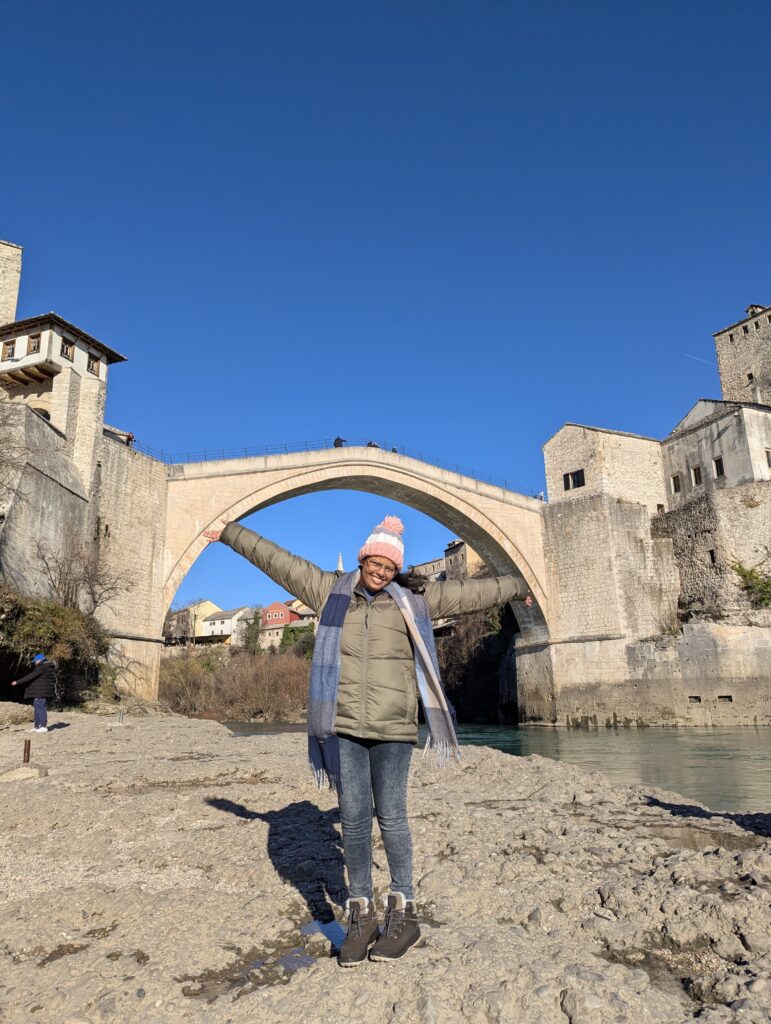
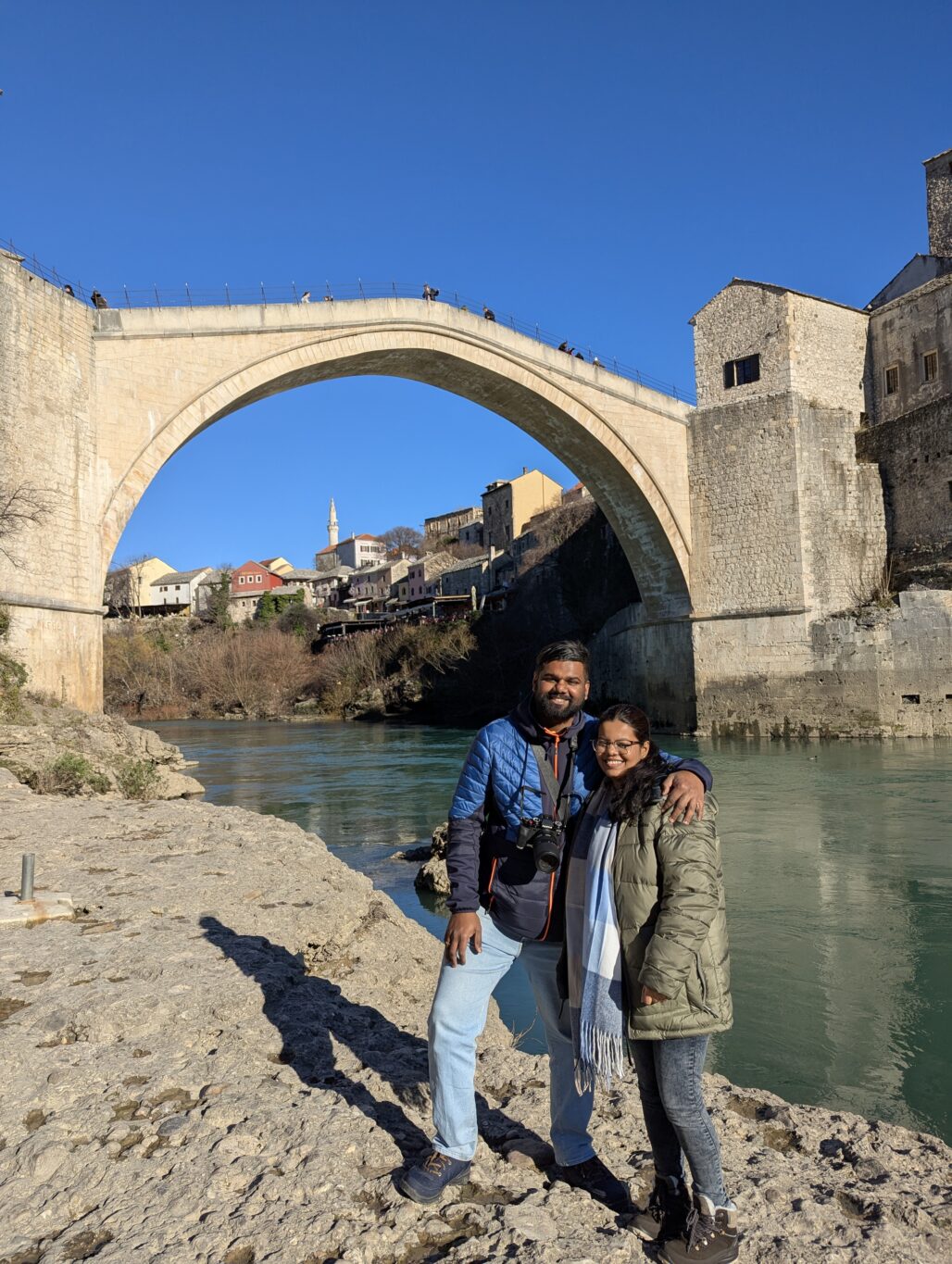
We continued our tour to Mostar Old Town. Lined with cobbled streets and souvenir shops, the old town provides a great view of the bridge. We strolled through the bazaar for a good 45 min and then our guide took us to Koski Mehmed Pasha Mosque– a small mosque with picturesque views. Another mosque in the vicinity was Karađoz Beg Mosque– designed by famous Turkish architect Mimar Sinan.
You will come across the Red Army 1981 graffiti everywhere on the walls of the Mostar streets. This is the ultras group of club FK Velež Mostar.
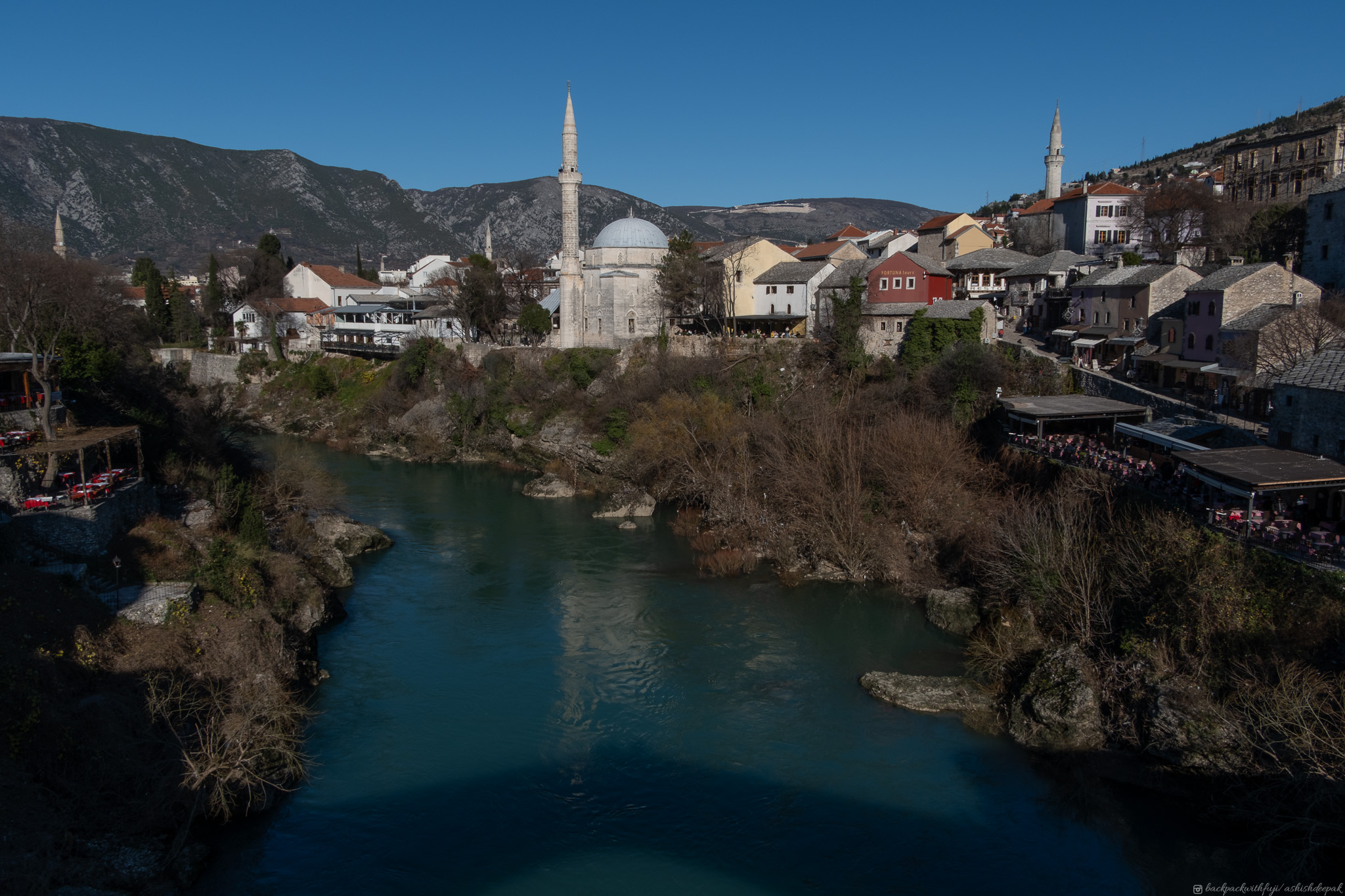
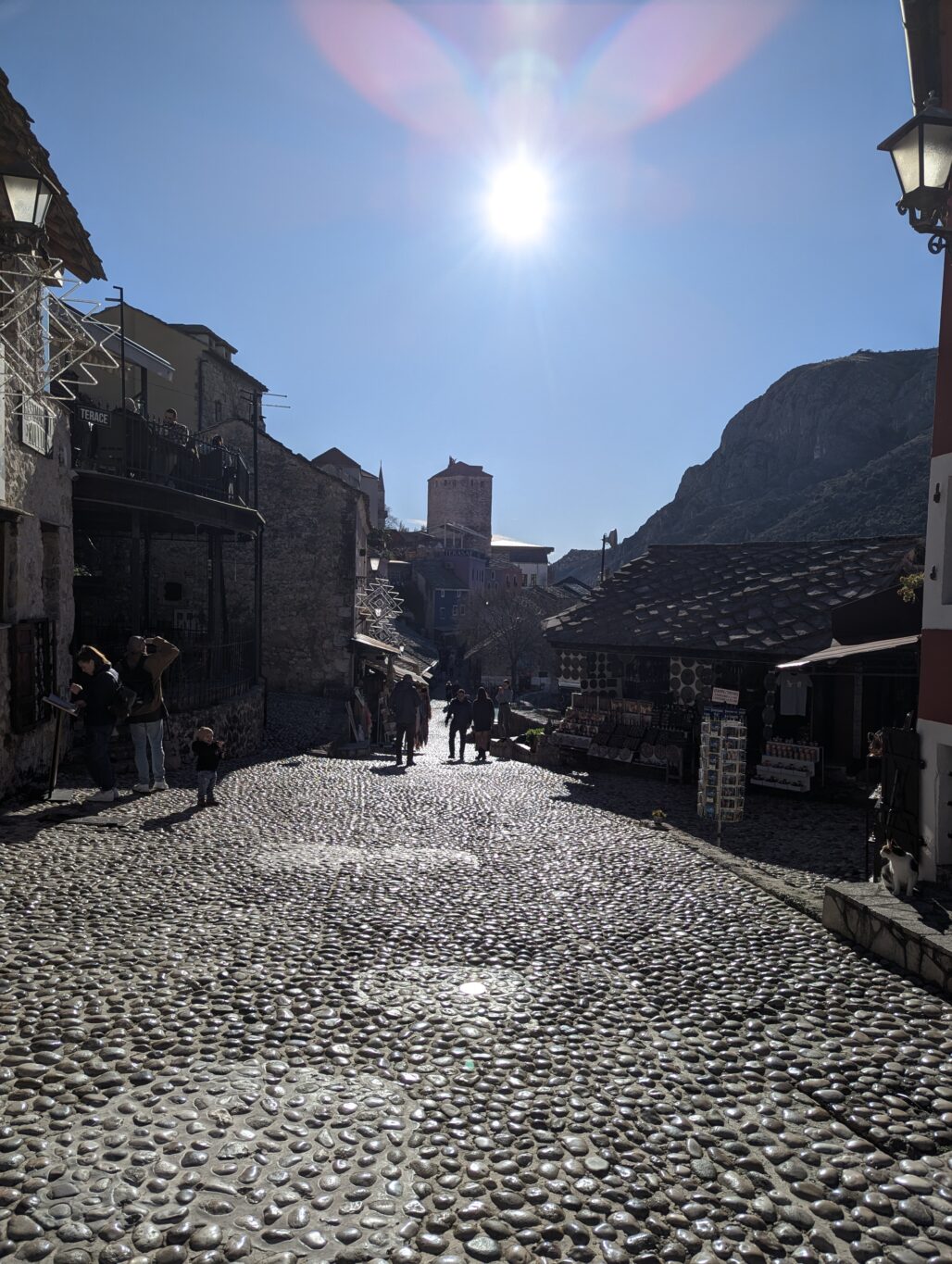
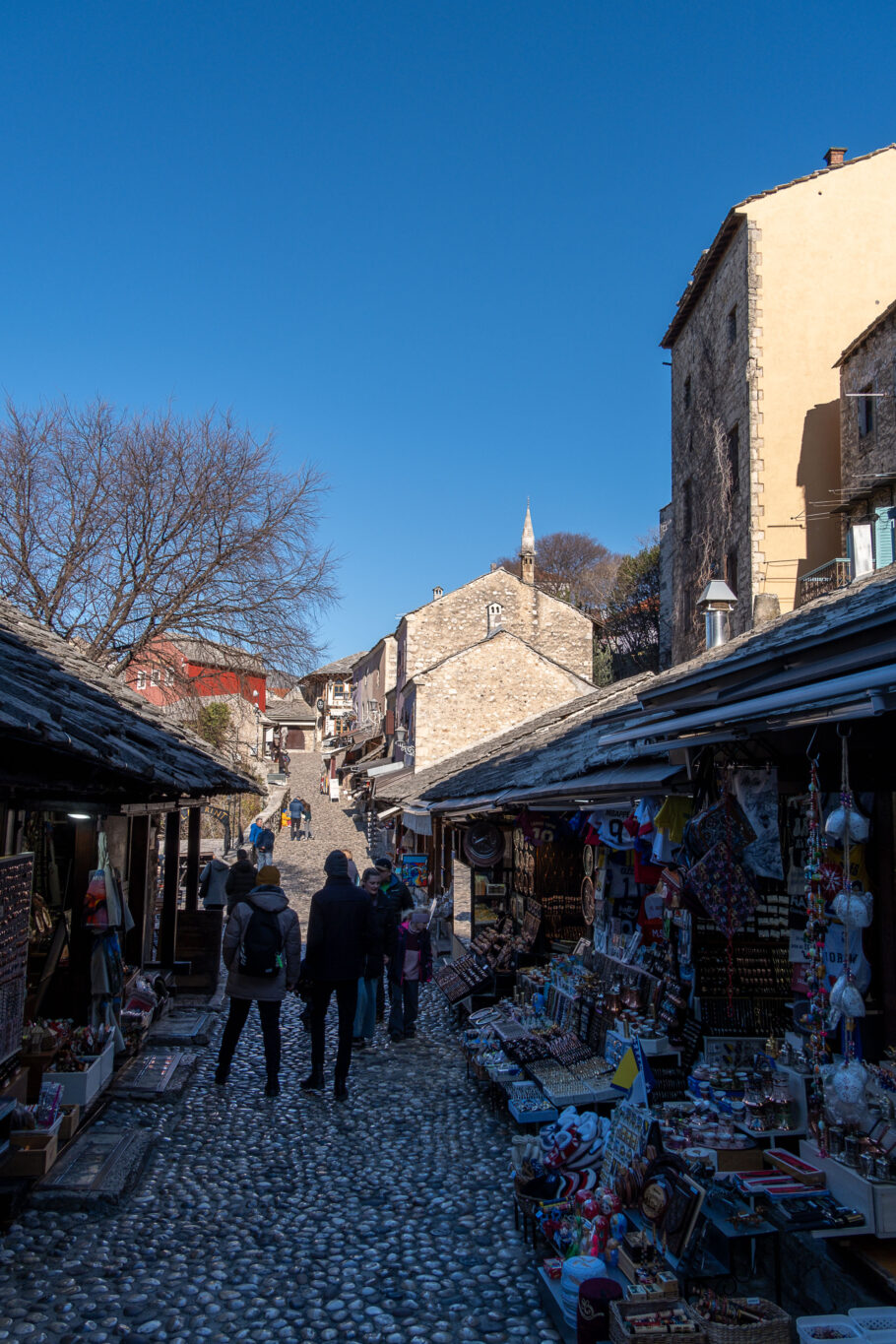
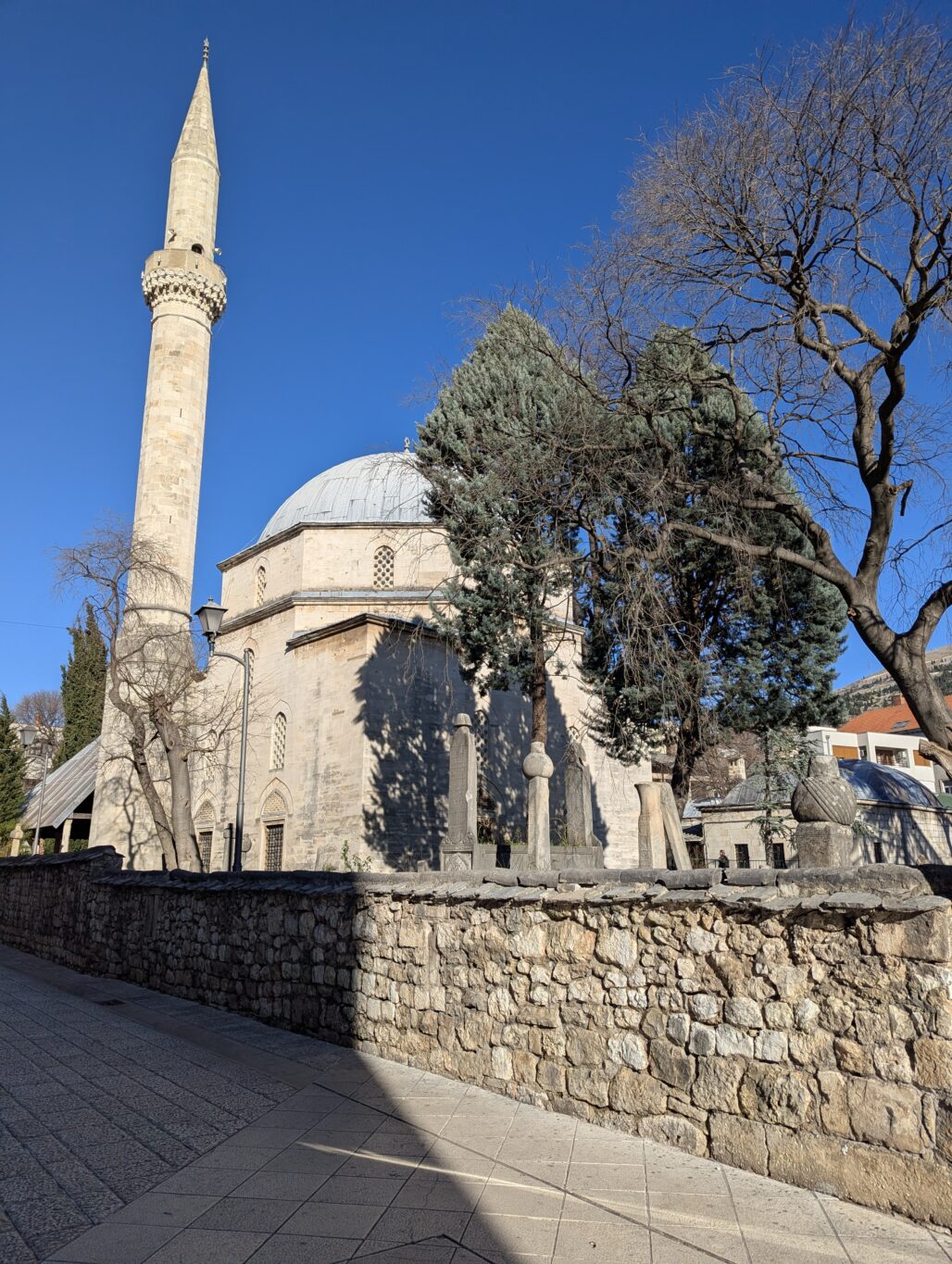
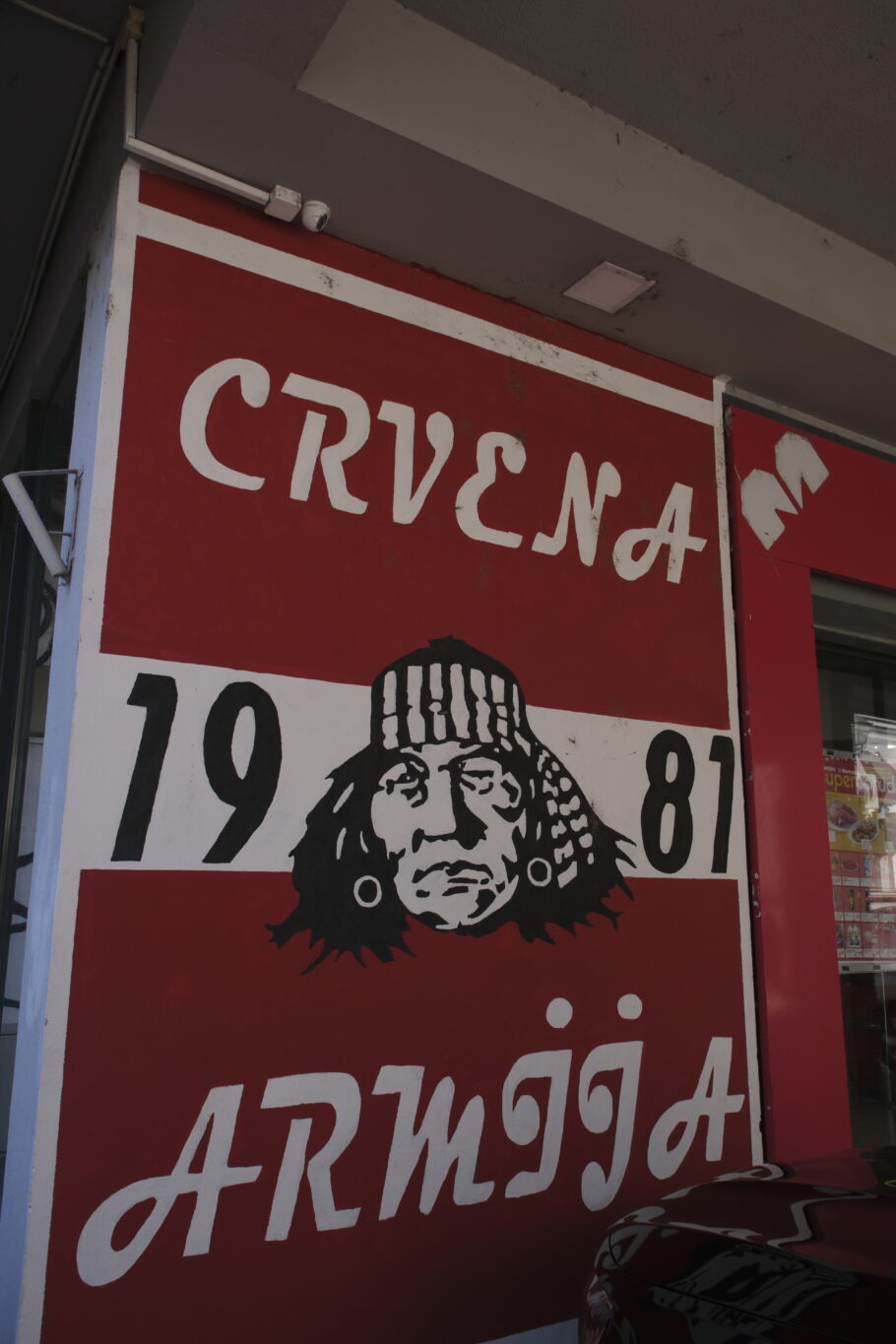
Kravica Waterfalls
Our next stop was at Kravica Waterfalls, a natural wonder, just a short drive from Mostar. This magnificent waterfall is known for its emerald-green water, which cascades down a series of limestone steps and forms a picturesque pool at the bottom. It reminded me of Plitvice lakes in Croatia.
If you like to visit Plitvice Lake, take a look at my other blog Plitvice LakesIt took us 45 minutes to reach the waterfalls from Mostar. Visitors can opt to hike down from the parking area to the lake or drive a little ahead and then walk to the lake. While approaching the waterfall, you’ll hear the soothing sound of rushing water and feel the cool mist on your skin. On a sunny day, the turquoise, crystal-clear water reflects the sunlight. We soaked in the beauty of the place for about half an hour.
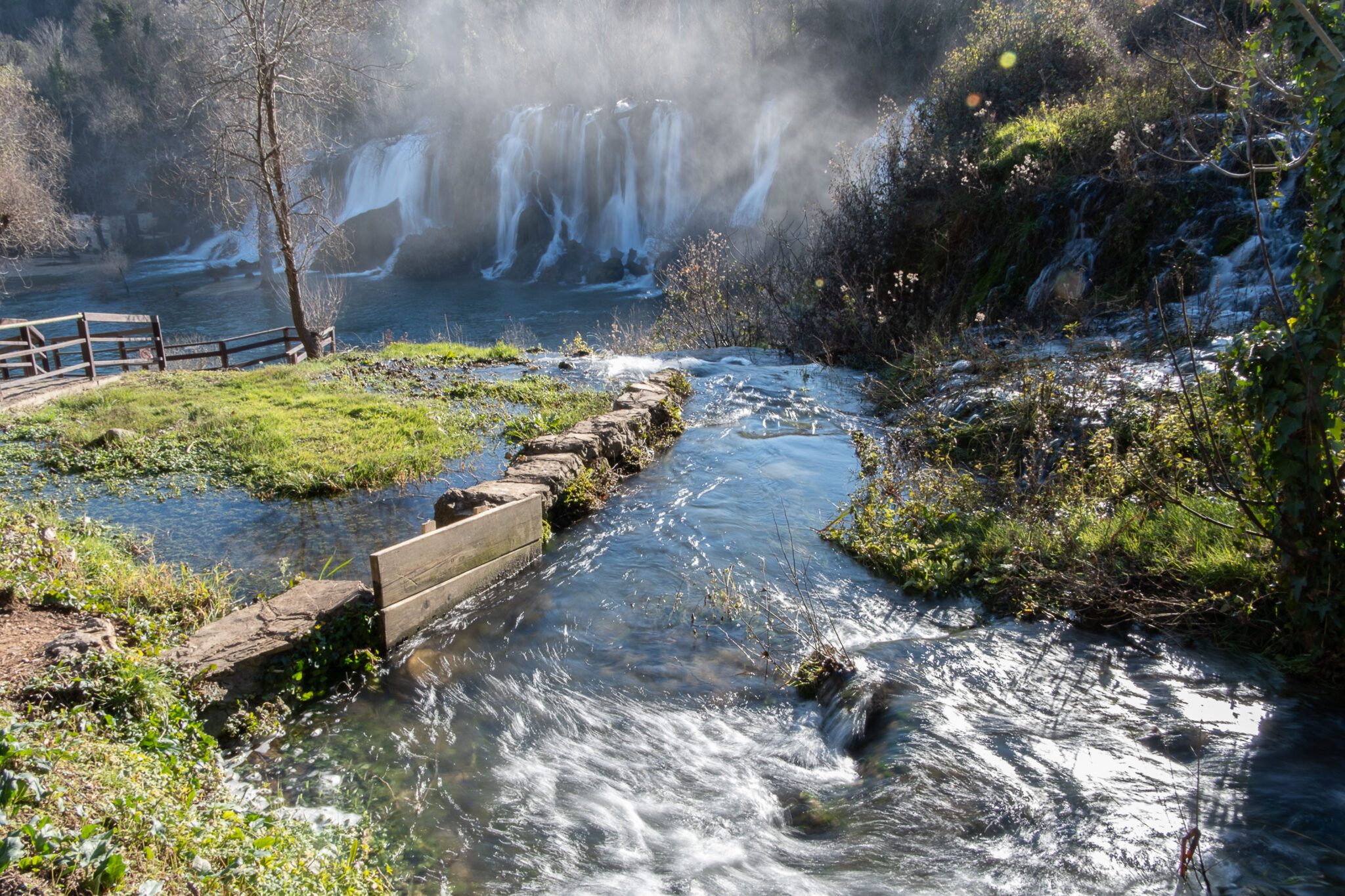
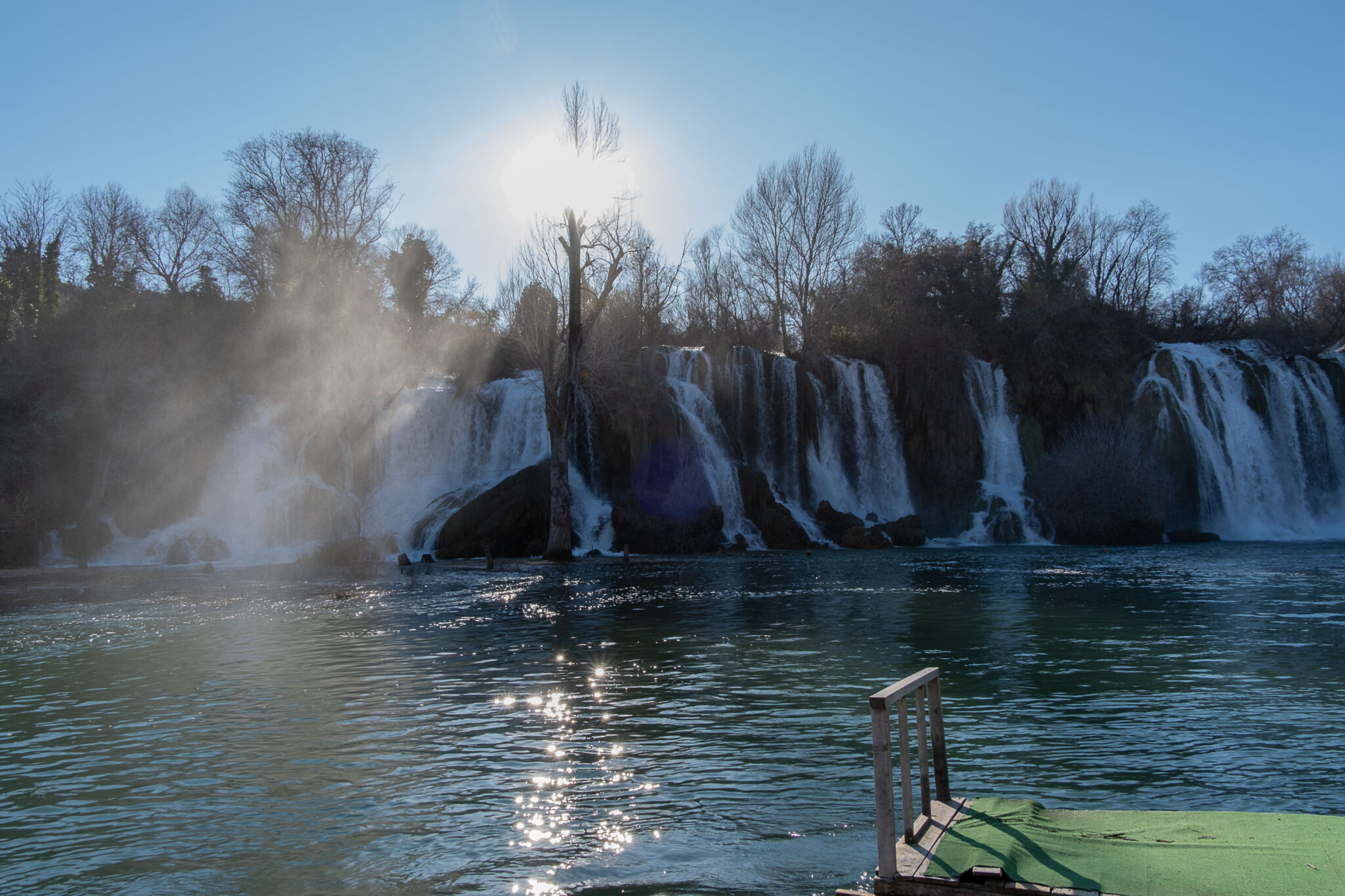
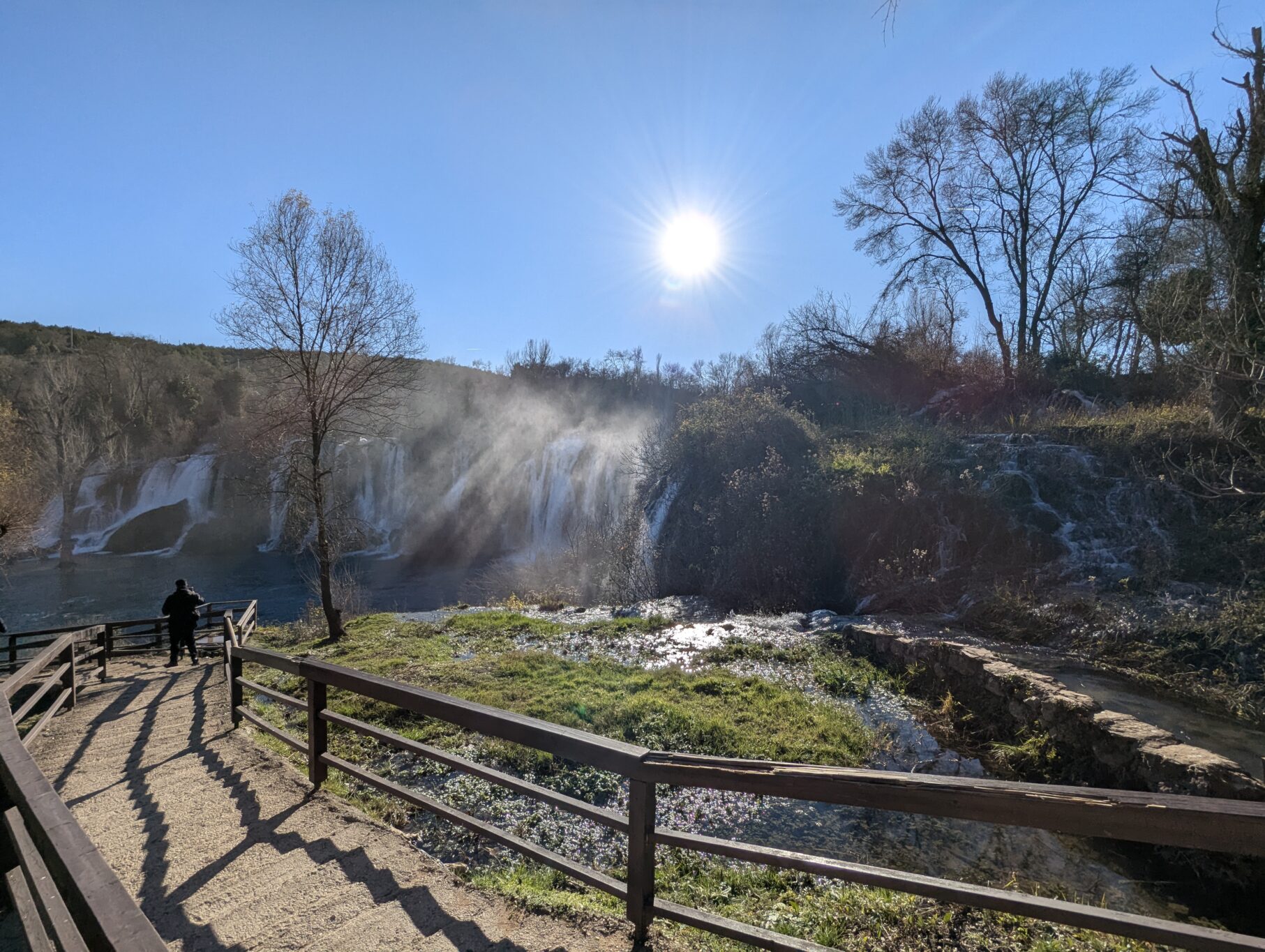
Pocitelj – UNESCO Heritage site
Located 30 km from Mostar, the historical site was used by the Turks and eventually destroyed in the Bosnian war. Pocitelj represents the best preserved architectural ensemble within the city walls in the region. Visitors can walk within the walls and get a glimpse of history. Public Hamam reflects the communal lifestyle of the Ottoman period, once used for social gatherings and communal bathing. Now the Hamam is a tourist site where you can stand between the well formations.
The fortress of Pocitelj, known as Kula, is perched on a hill overlooking the town. It offers visitors insights into the town’s strategic defensive history and breathtaking views of the Neretva Valley.
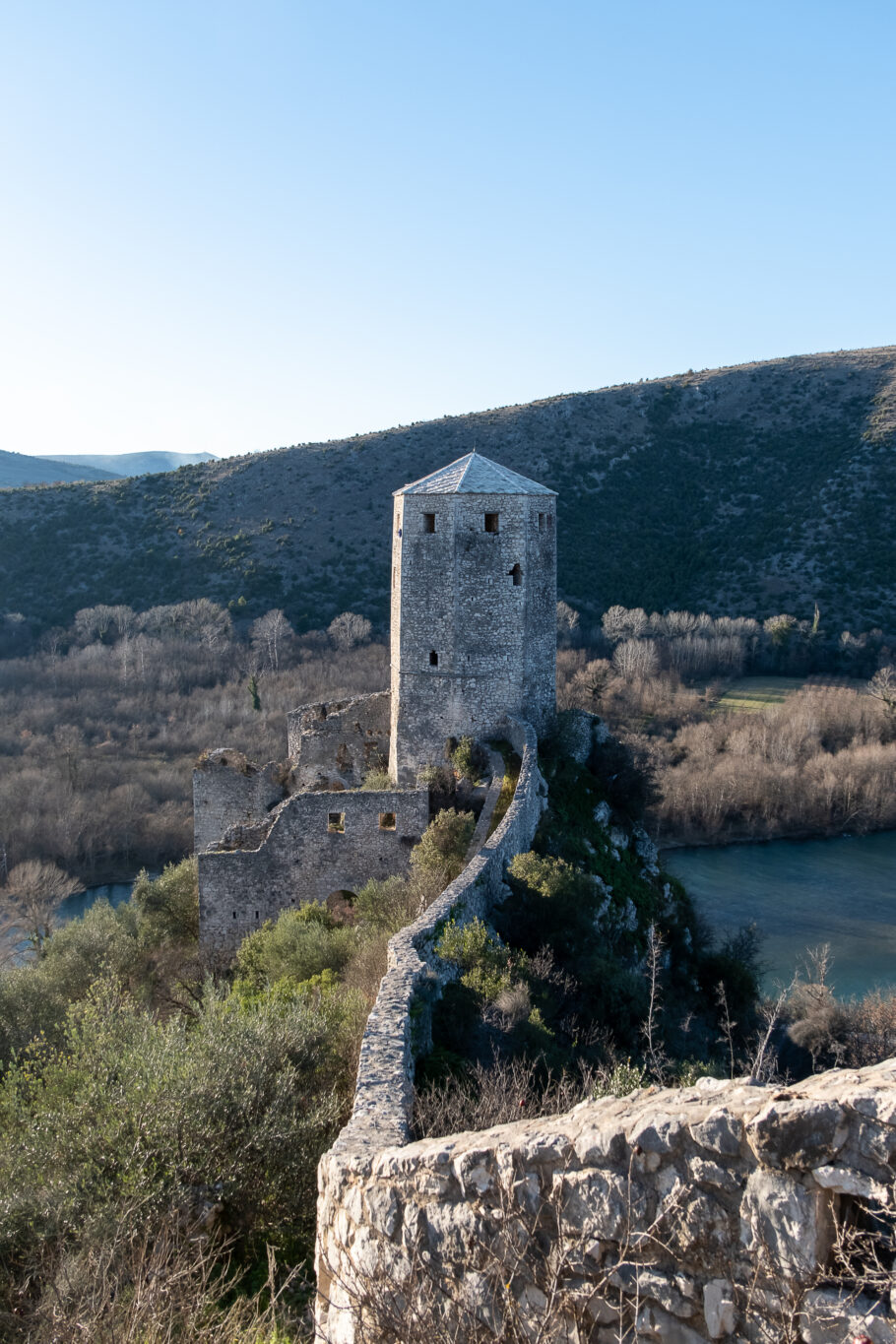
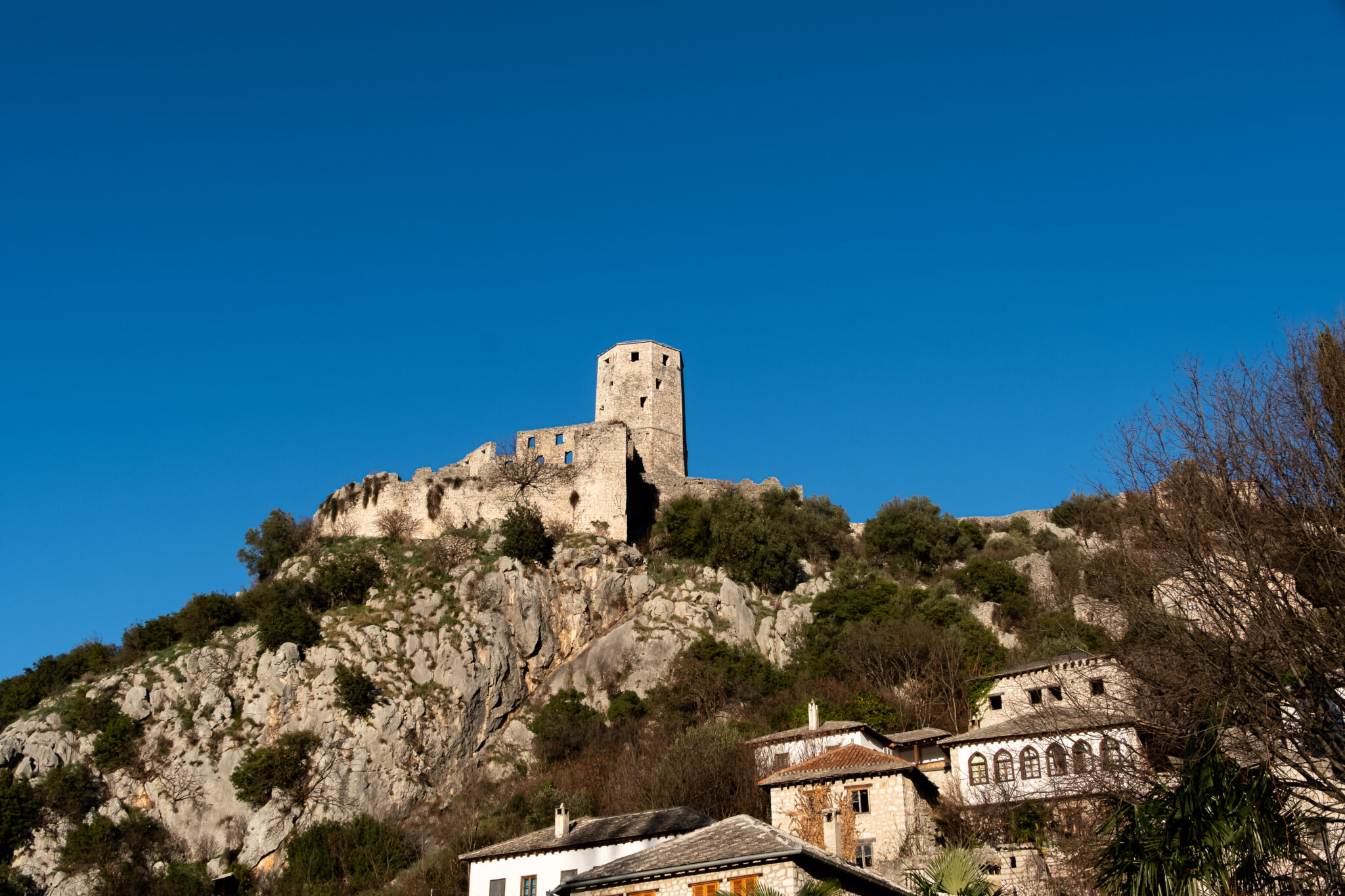
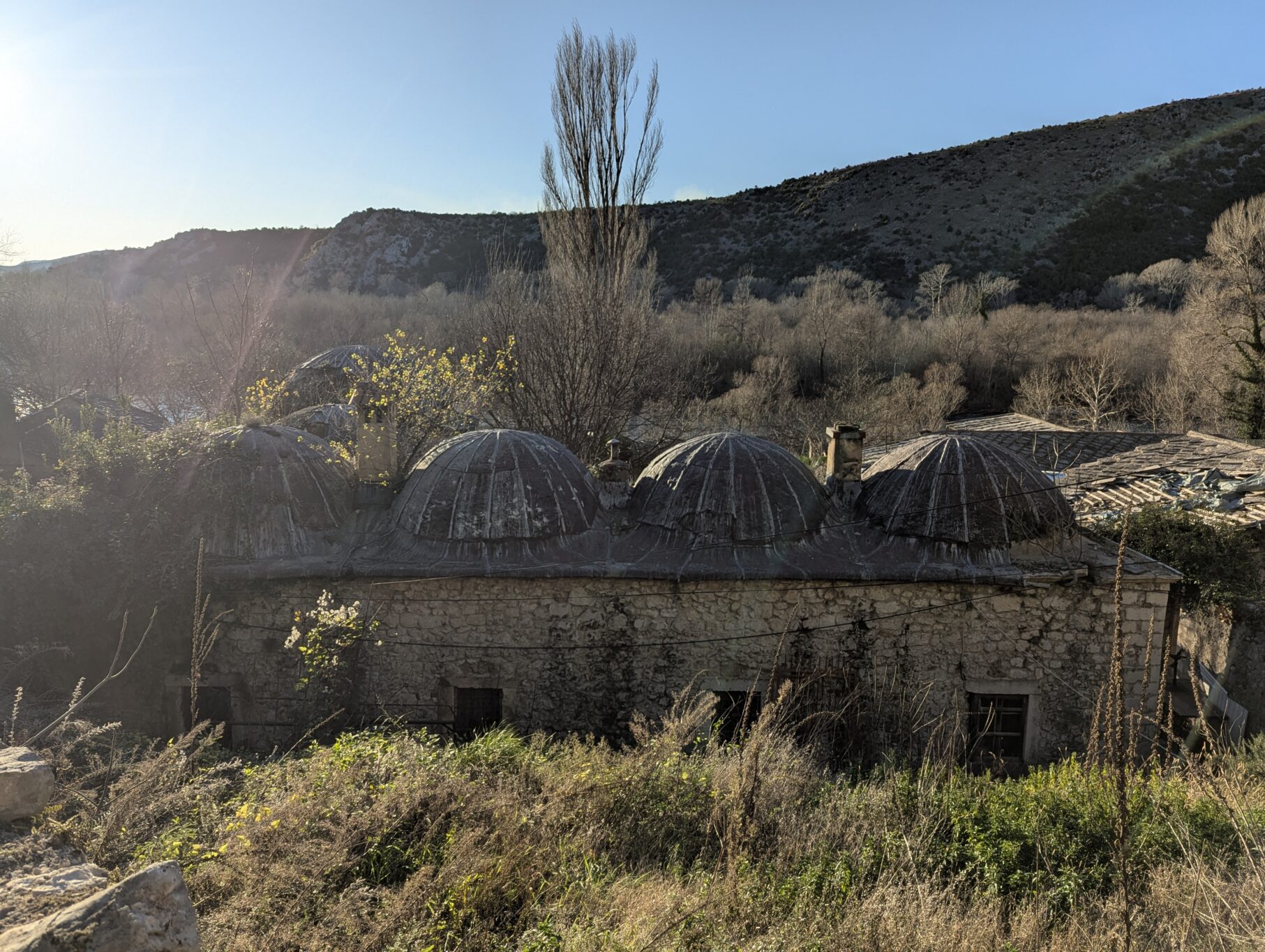
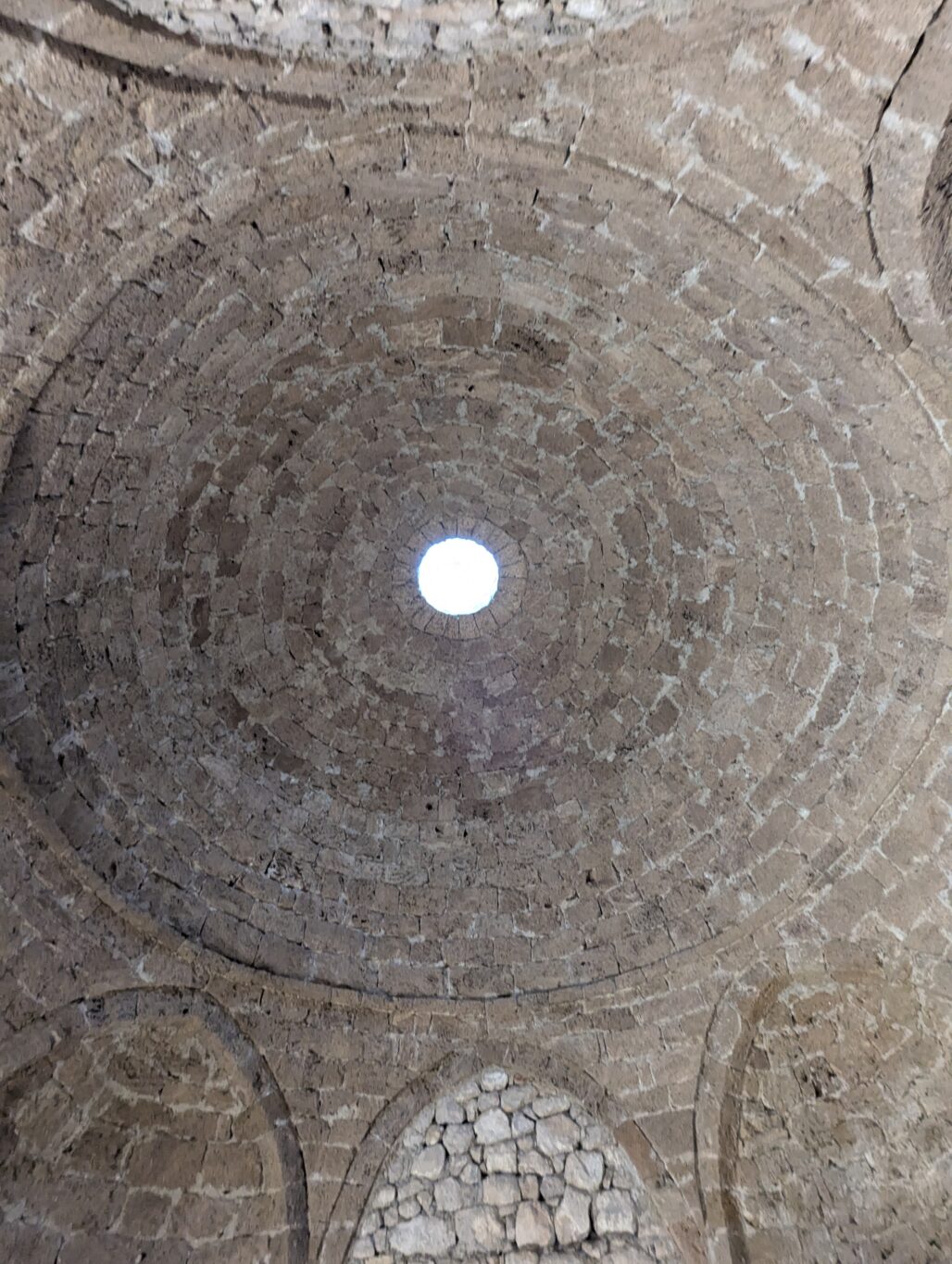
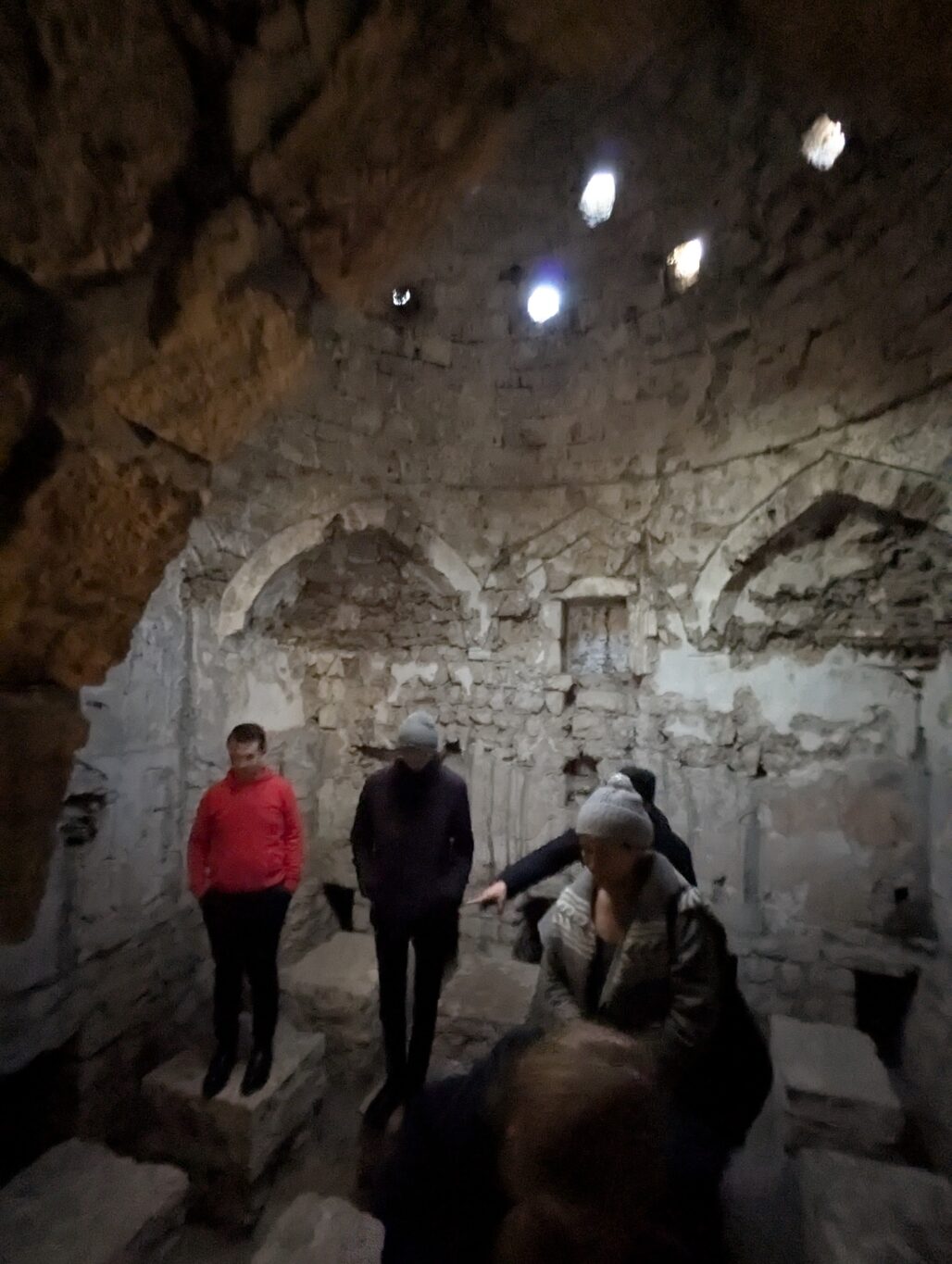
Blagaj Tekke
Our last site of the tour is a unique building and a monastery from the 16th century. The beautiful Sufi building is carved out on the cliffs, a Dervish monastery on the banks of the Buna River. It attracts visitors with its architecture, spirituality, and cultural heritage. During a visit to Blagaj Tekija, visitors can explore the interior of the building and also walk along the Buna River and admire the beautiful views.
Ticket Price: A ticket for Blagaj Tekija usually costs around 10 KM (convertible marks)
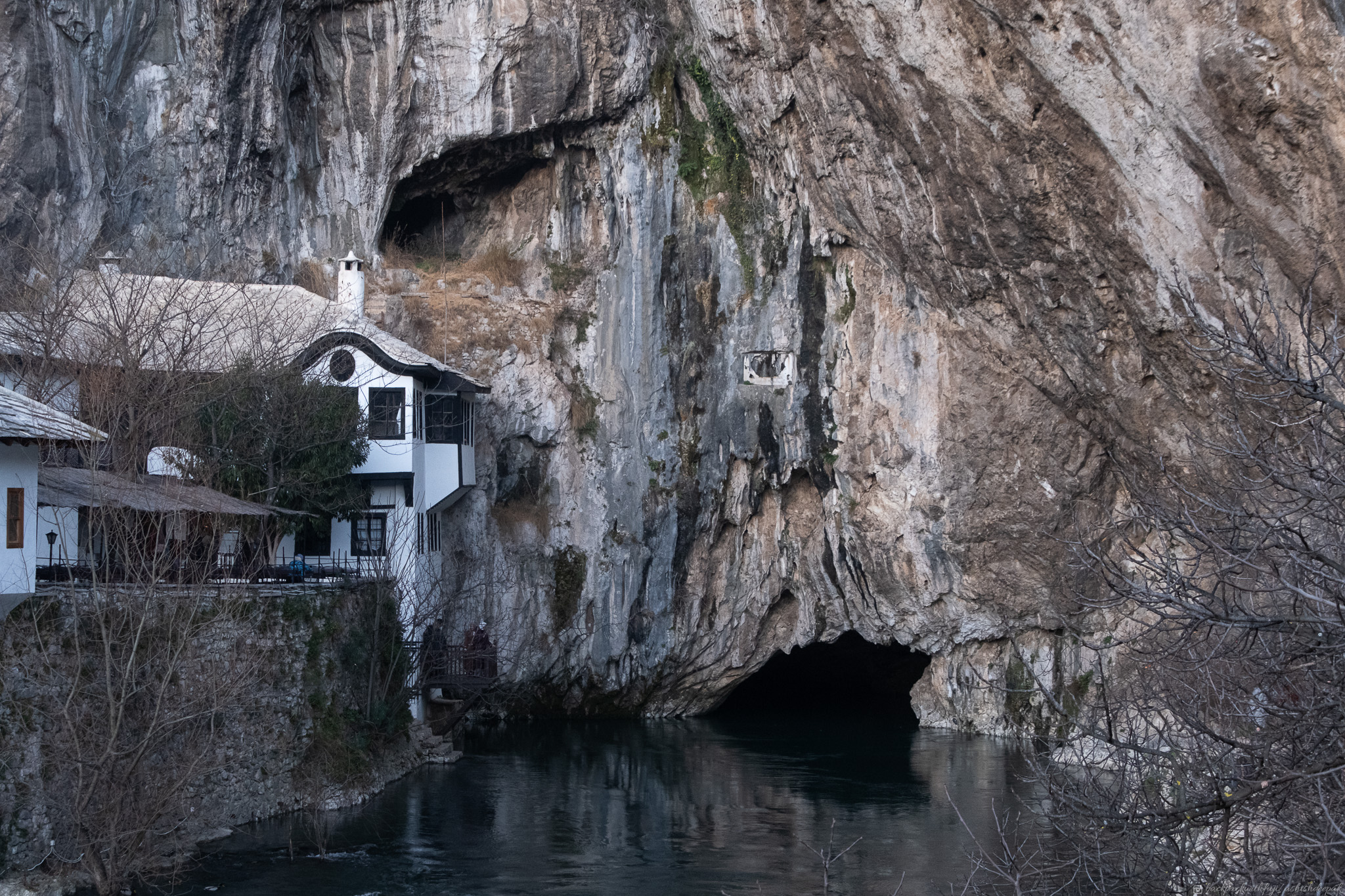
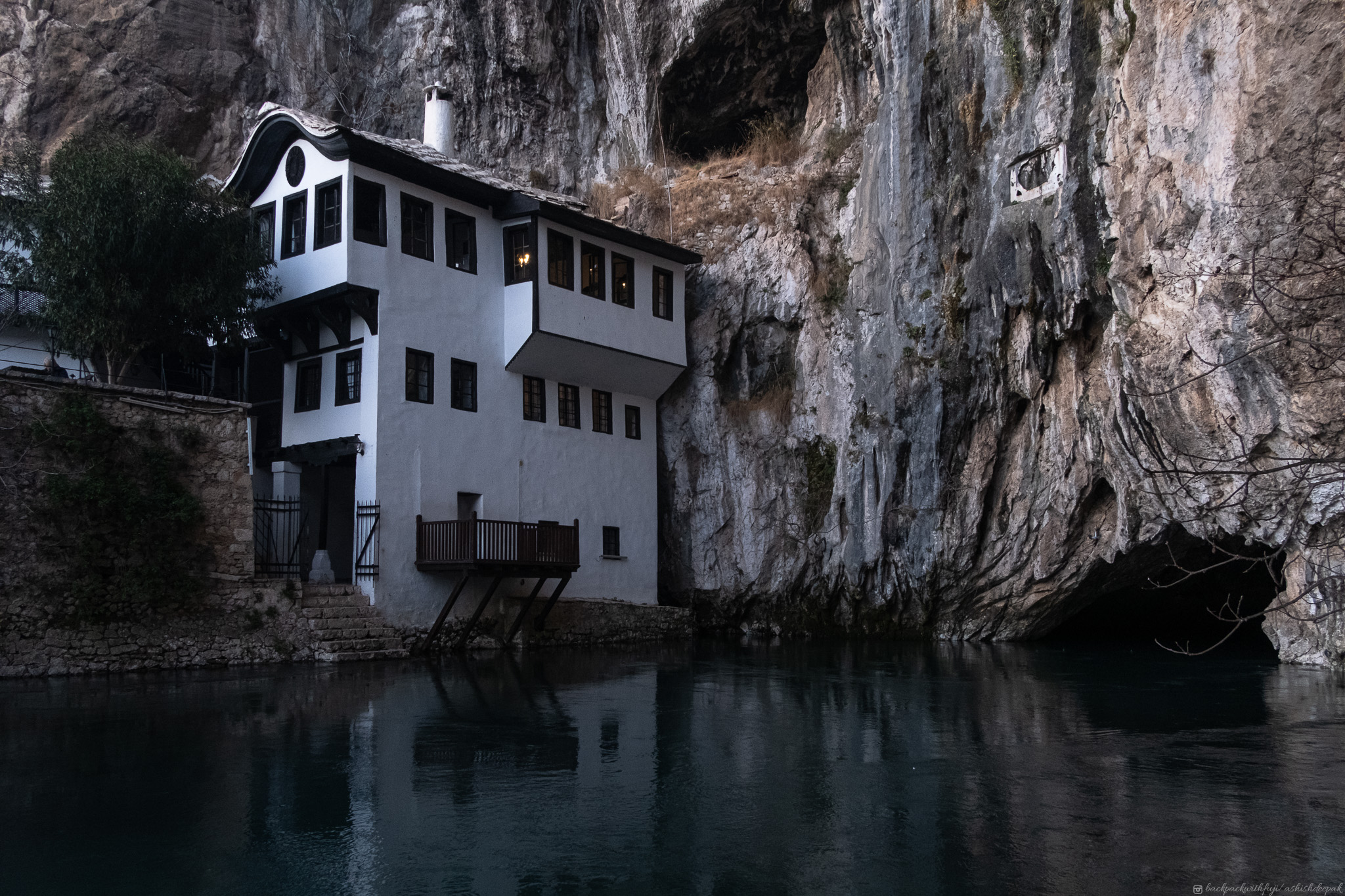
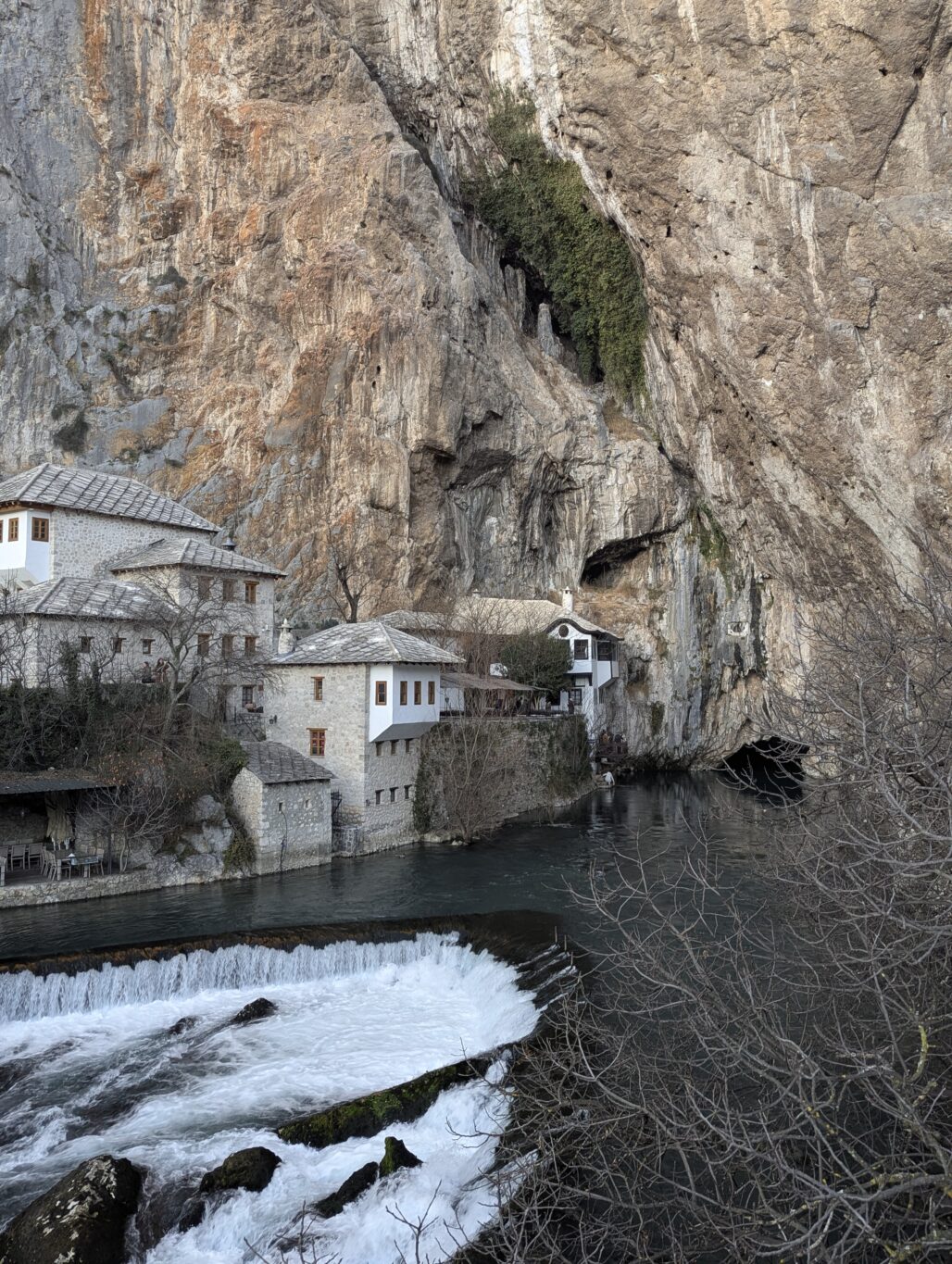
Burek King
On the way back to Sarajevo, we unanimously decided to stop at Burek King and try out the traditional Bosnian Burek. Our guide pre-ordered the Bureks we wanted to try so that we would be served fast as soon as we arrived. Burek is a must-try in Bosnia. You get plenty of options like, cheese, potato, meat, spinach etc. I went for the Potato Burek and it was delicious. It was soft to bite and was filled with a well-cooked filling of potatoes. This delicacy is made on a wooden stove to preserve the texture and for a smokey flavour.
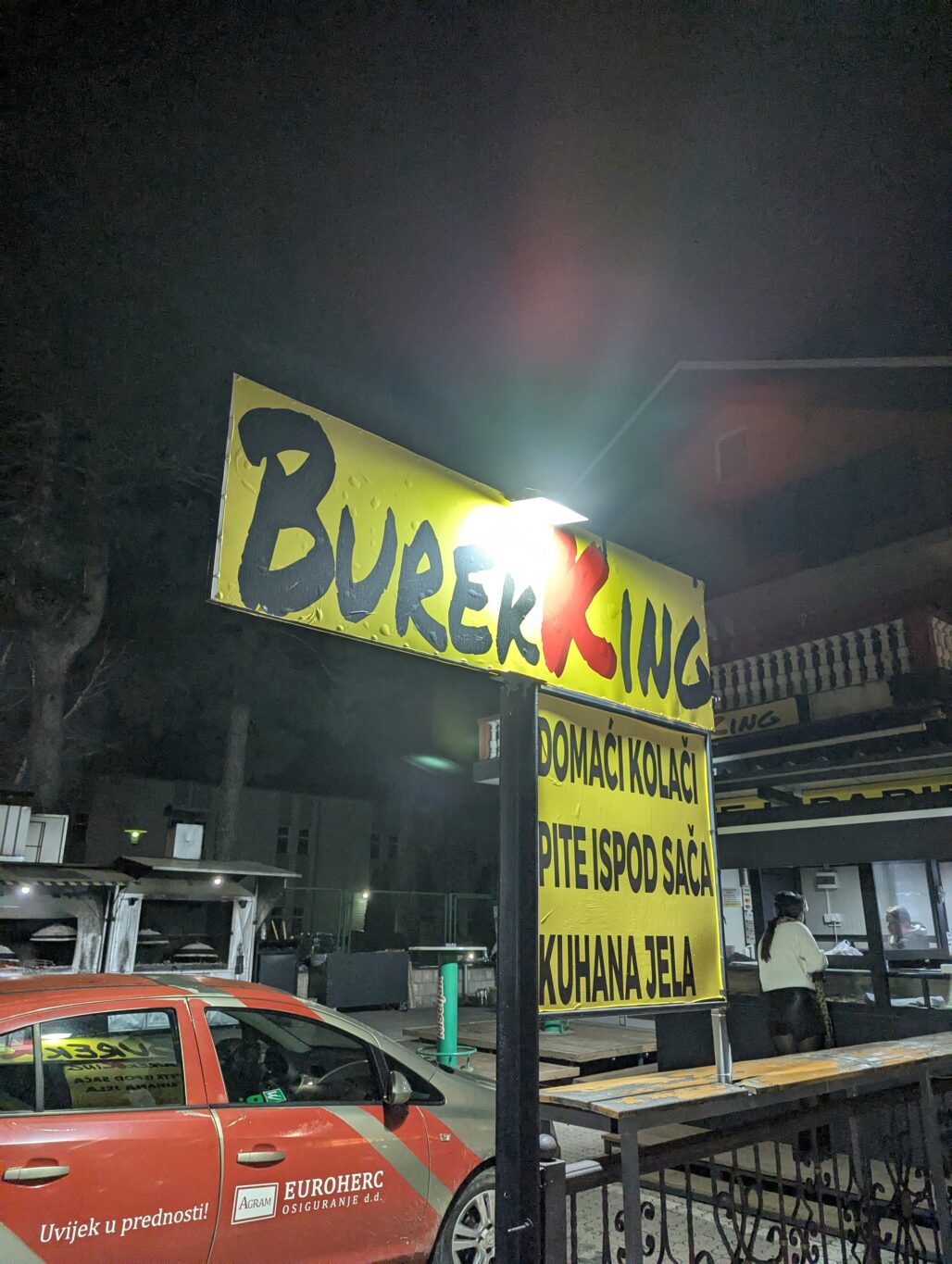
Useful Links
Mostar tour | Full day guided tour to amazing Herzegovina

